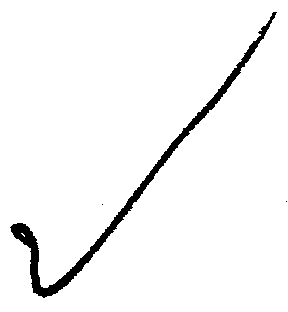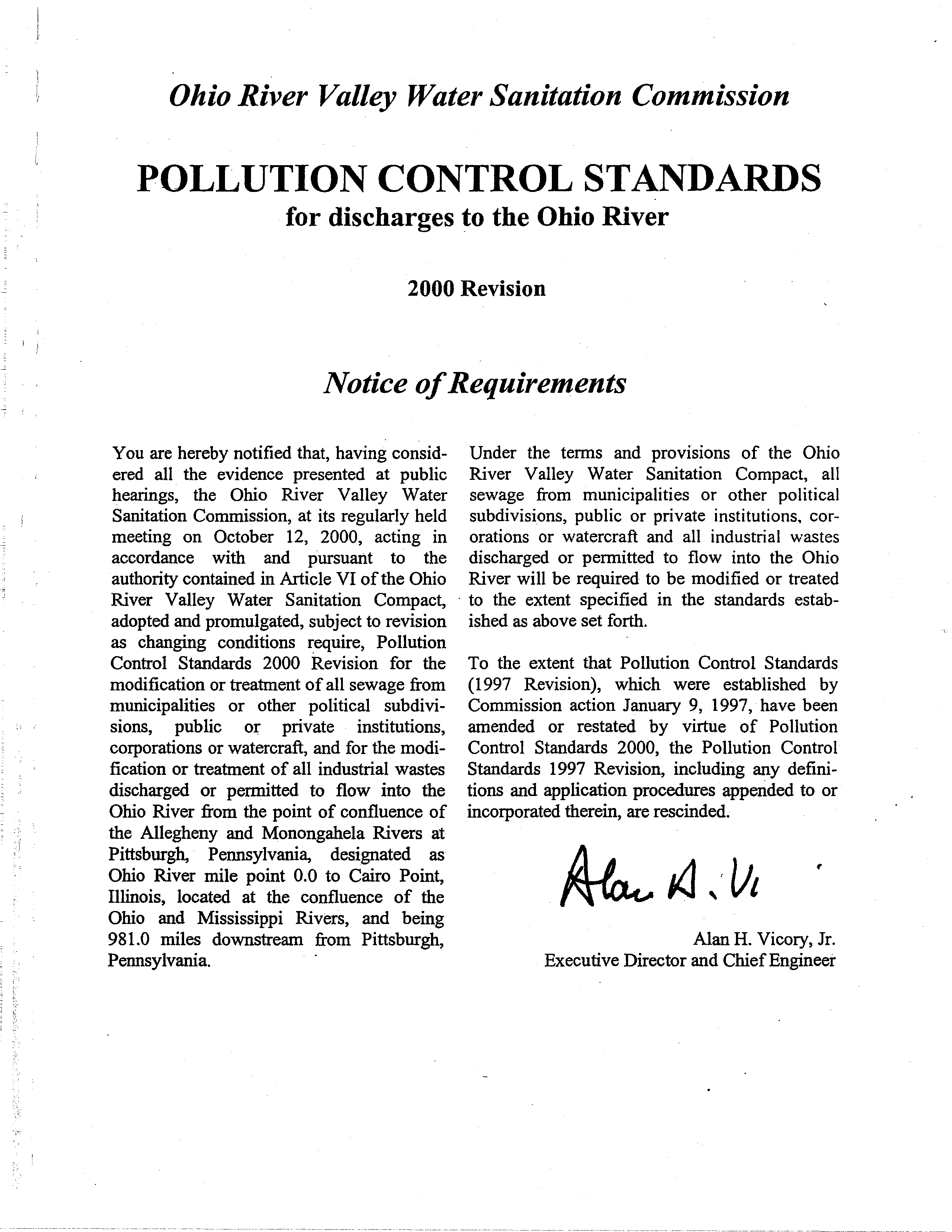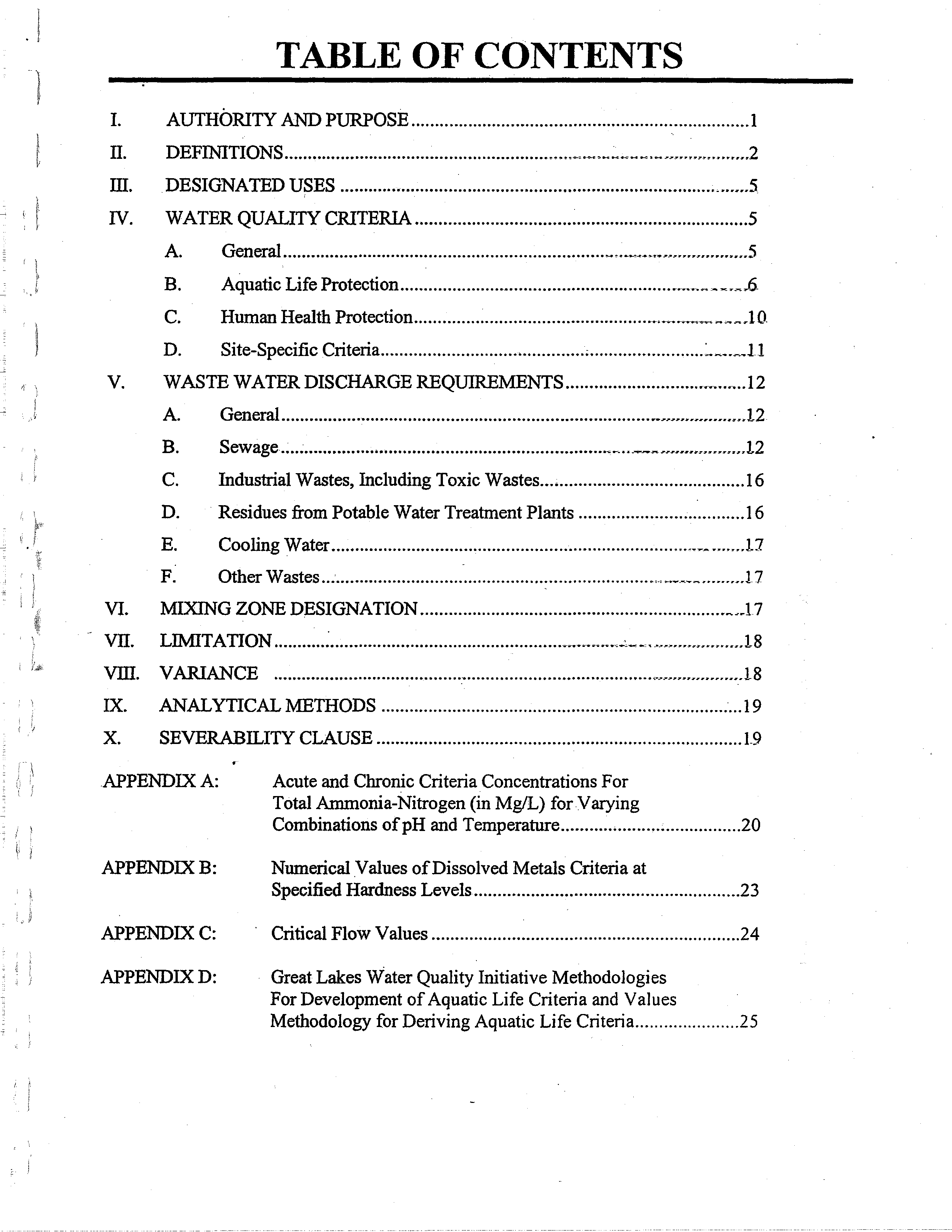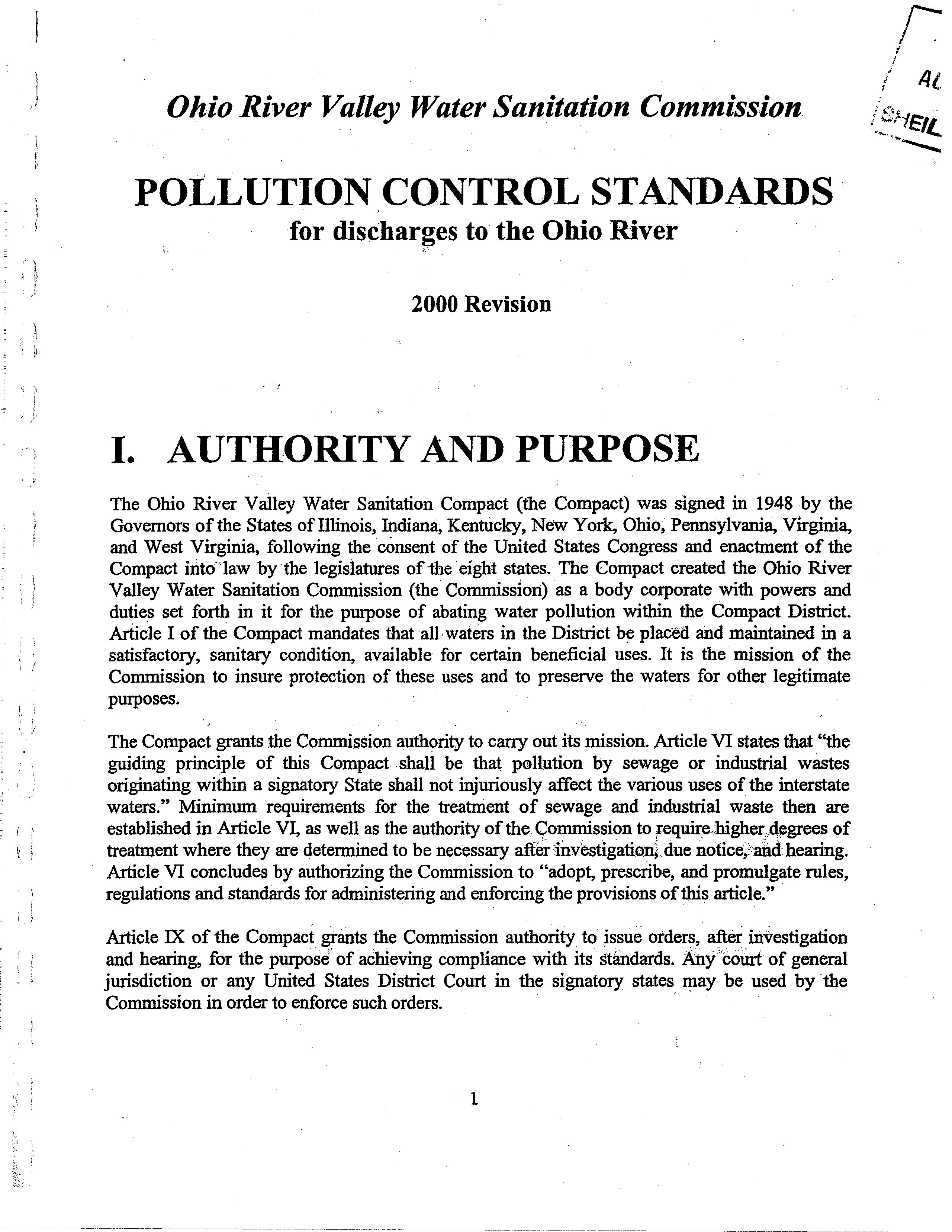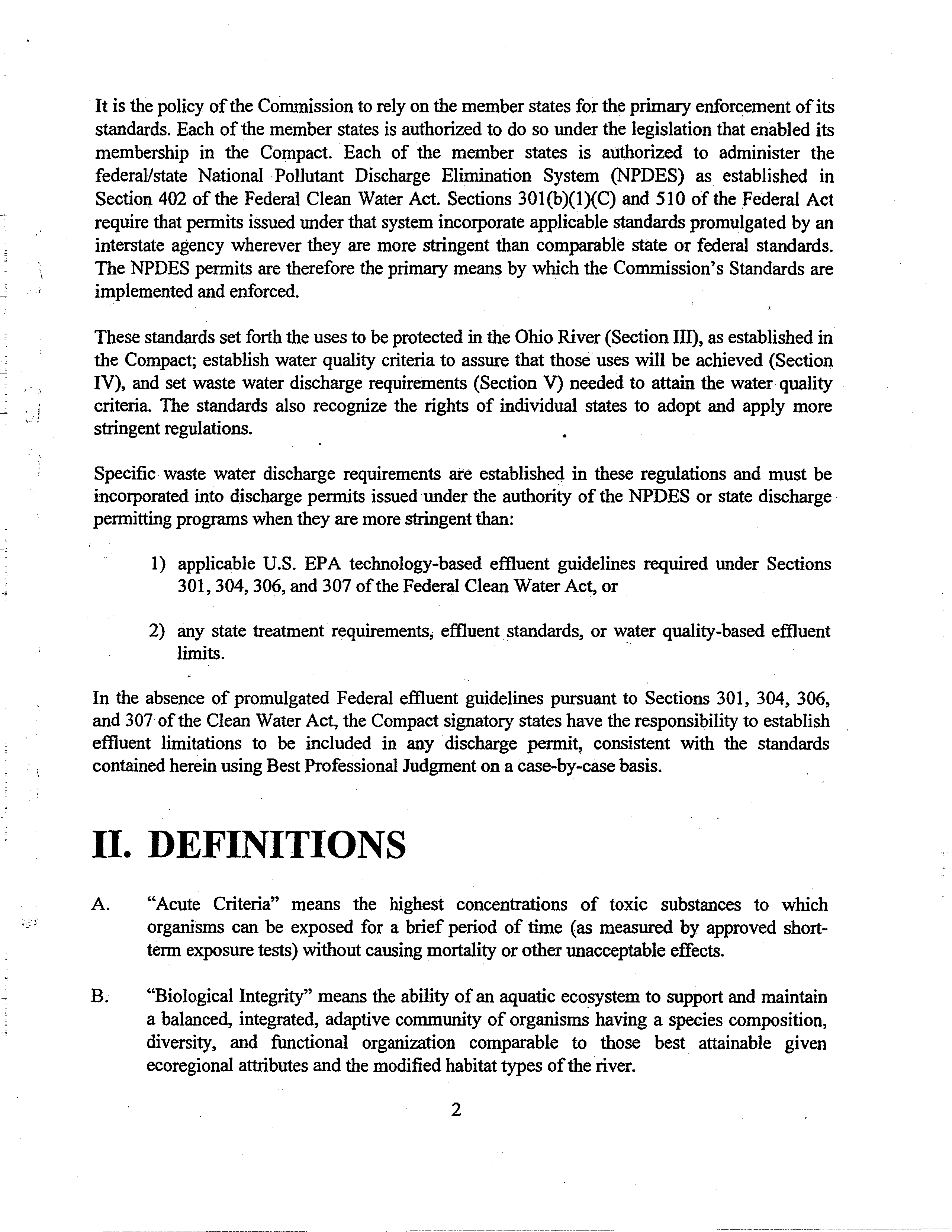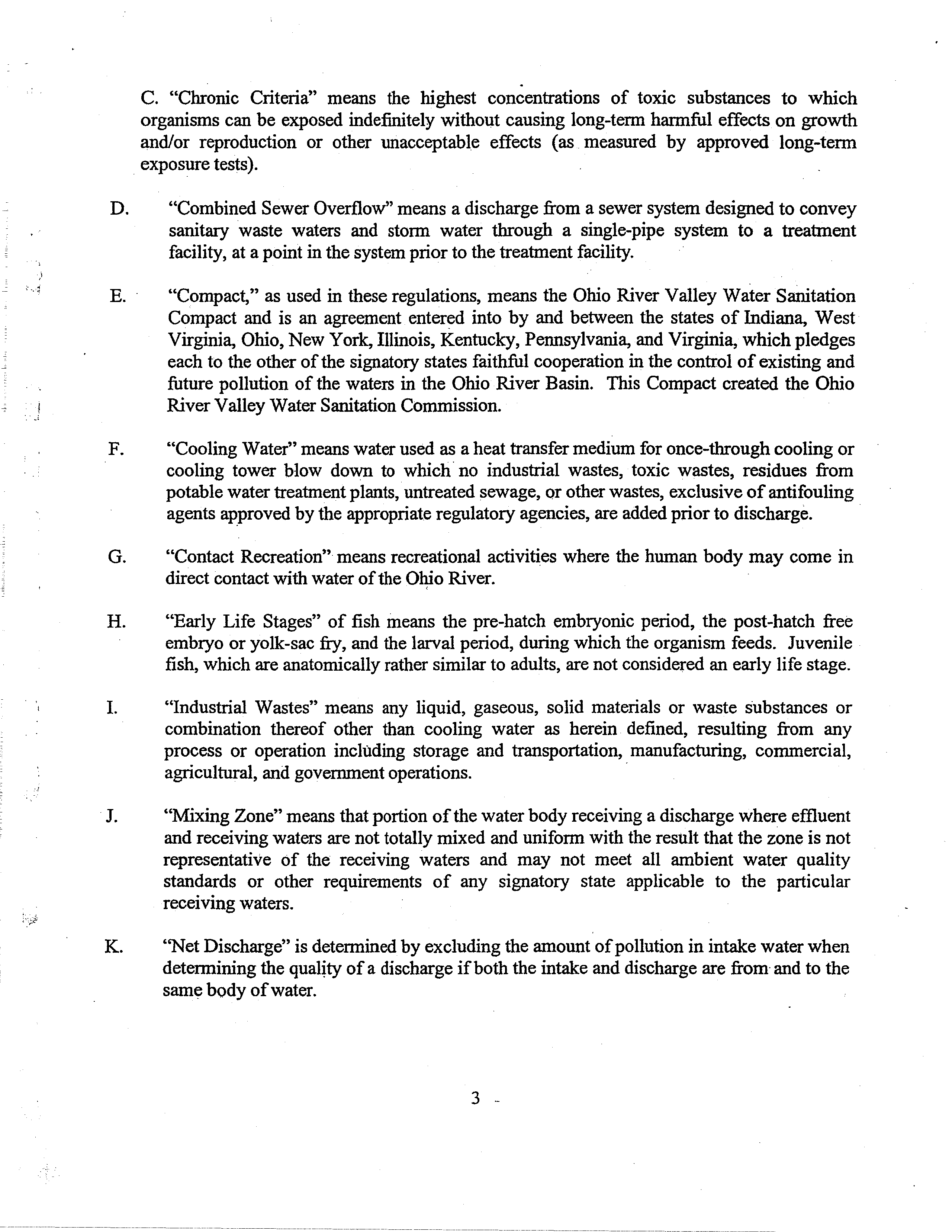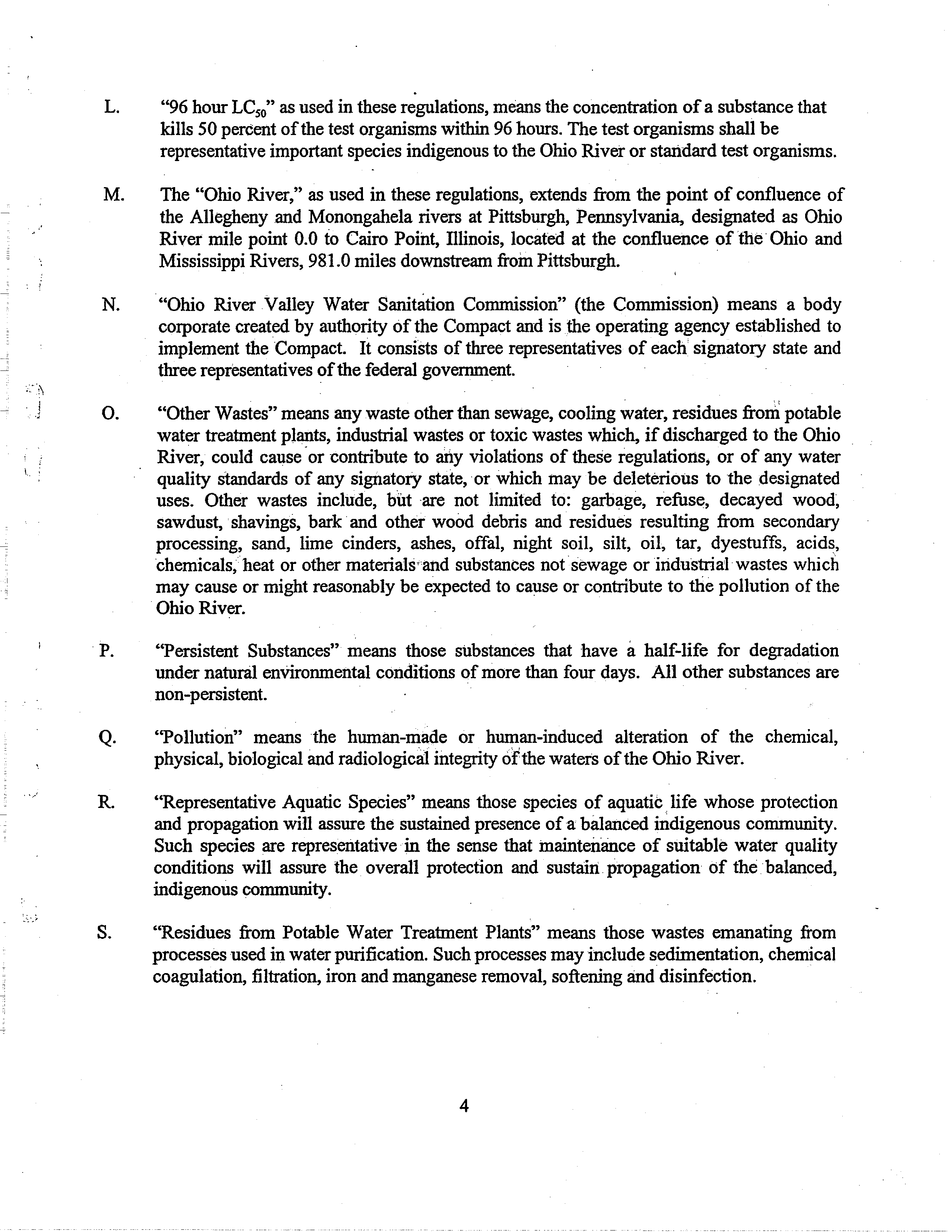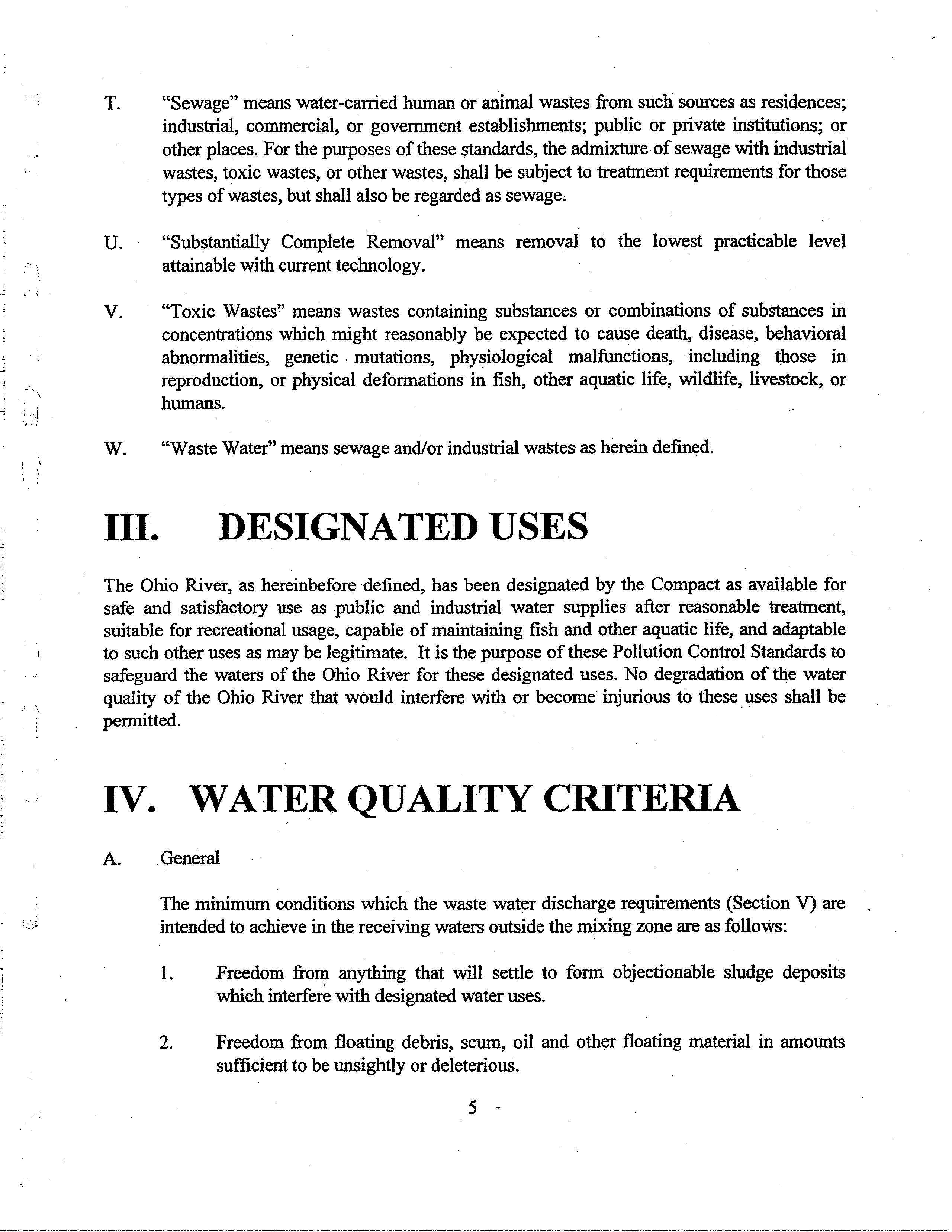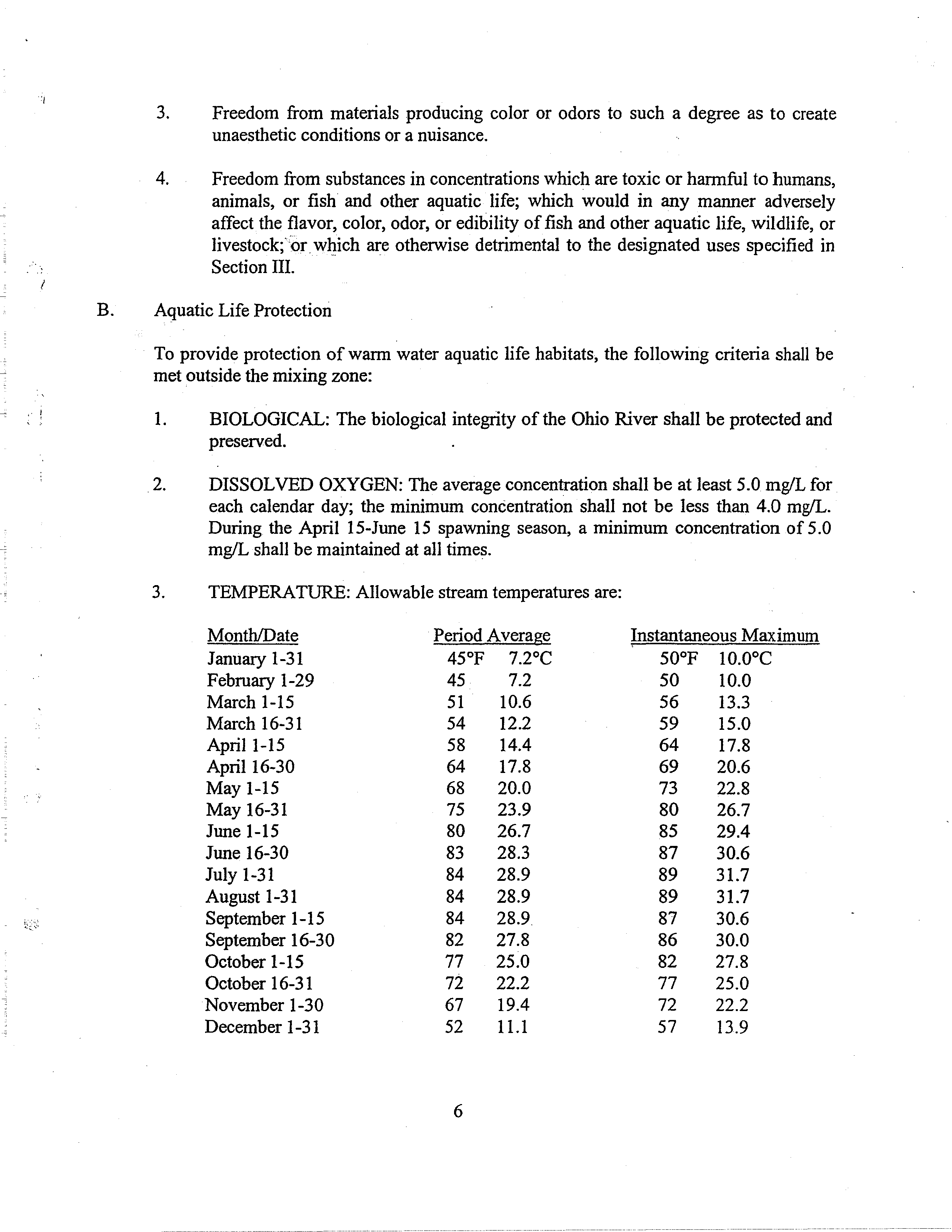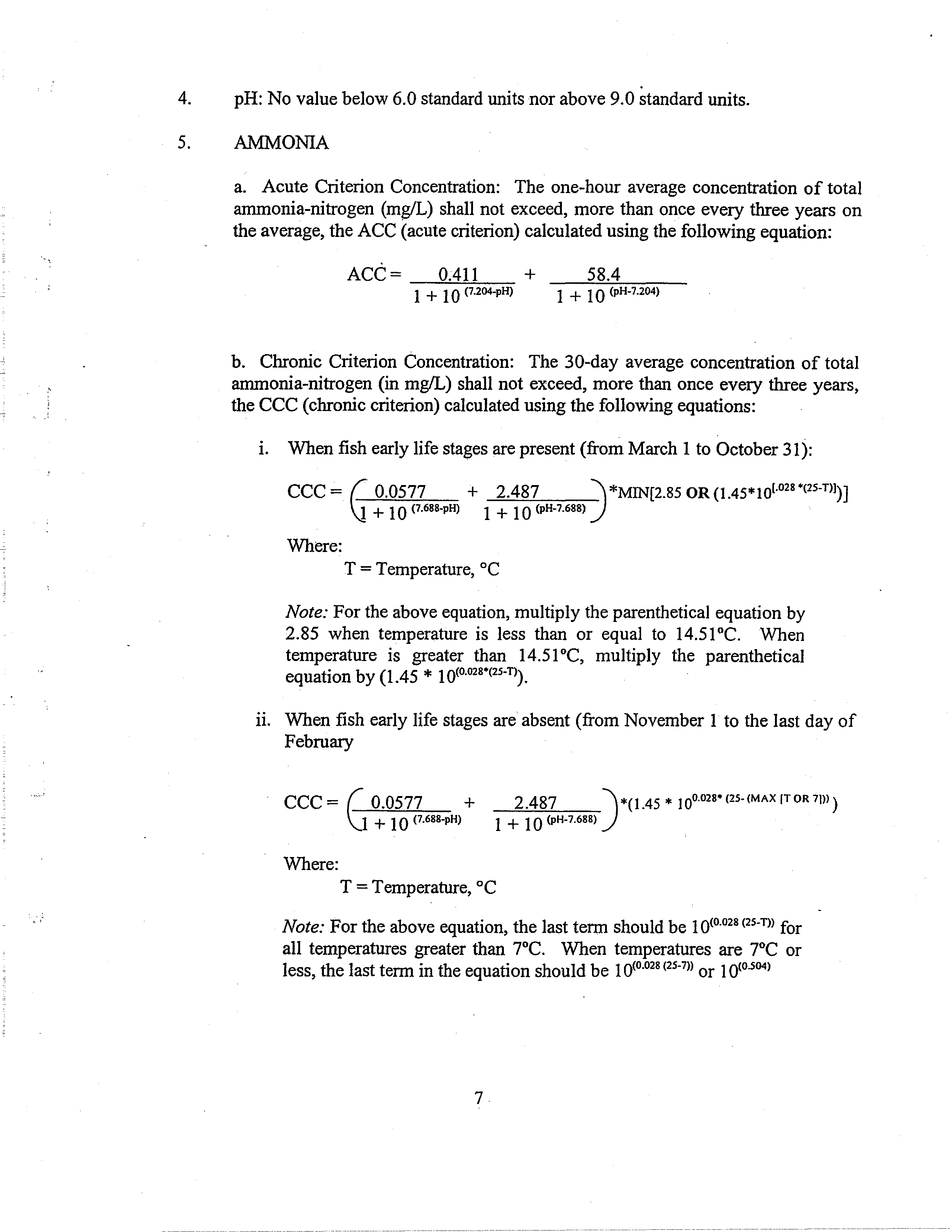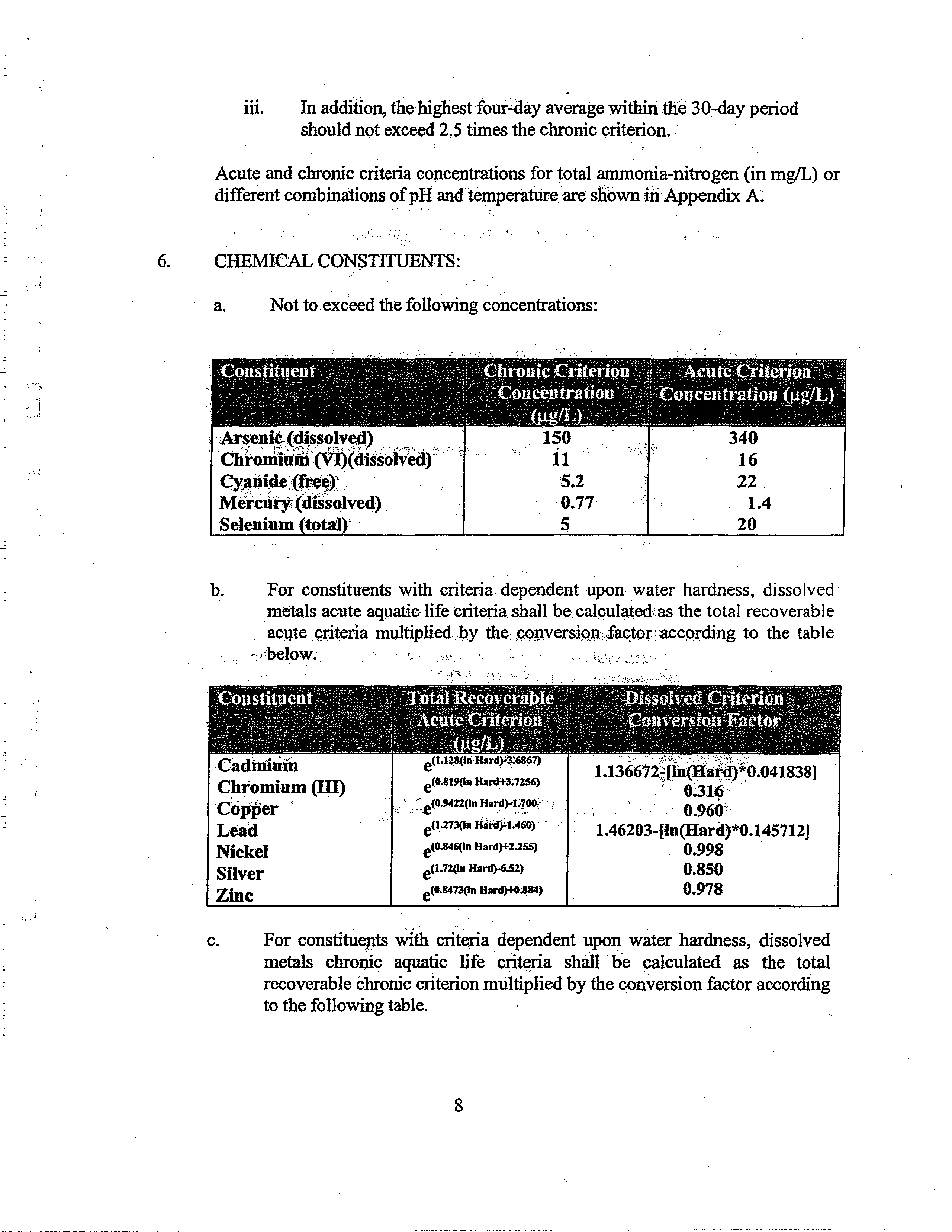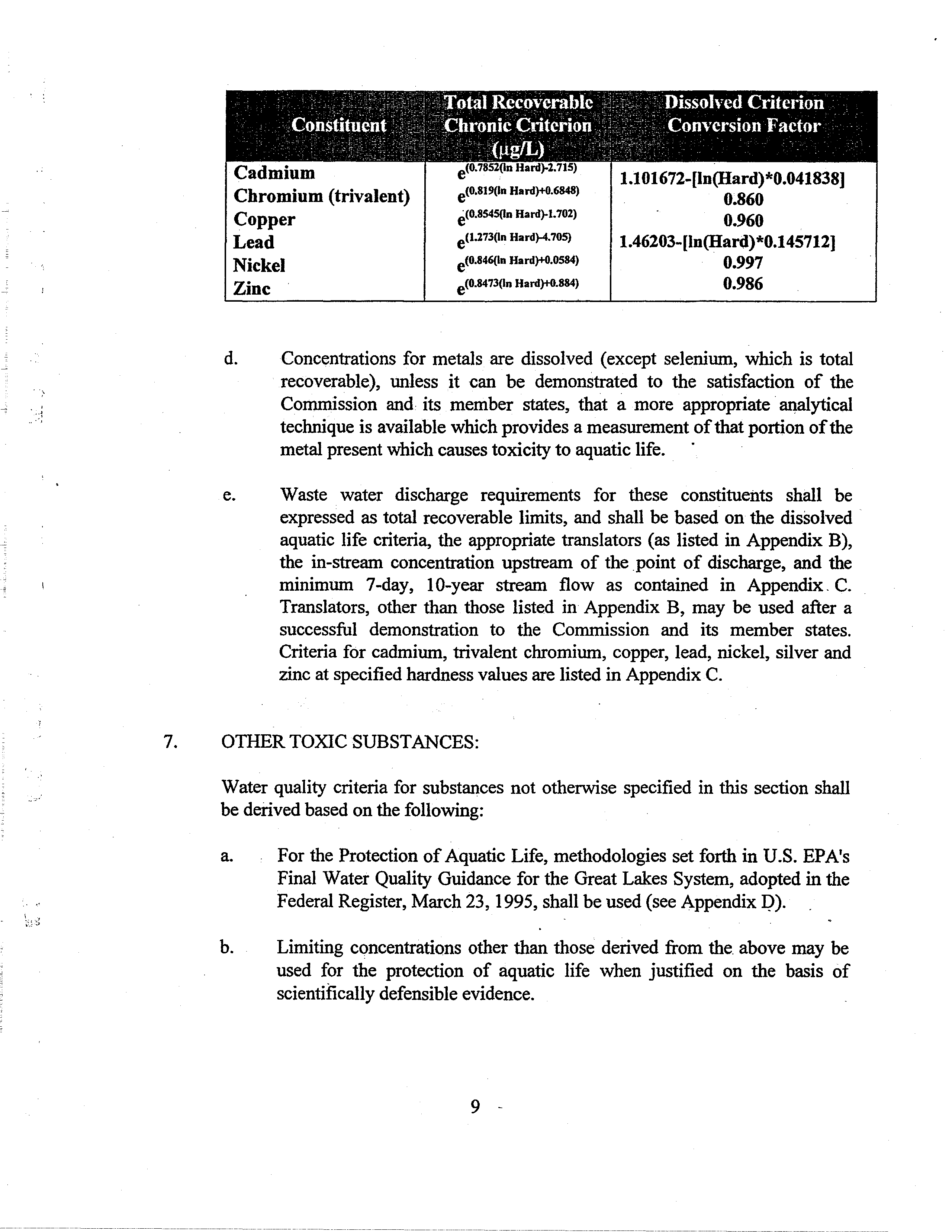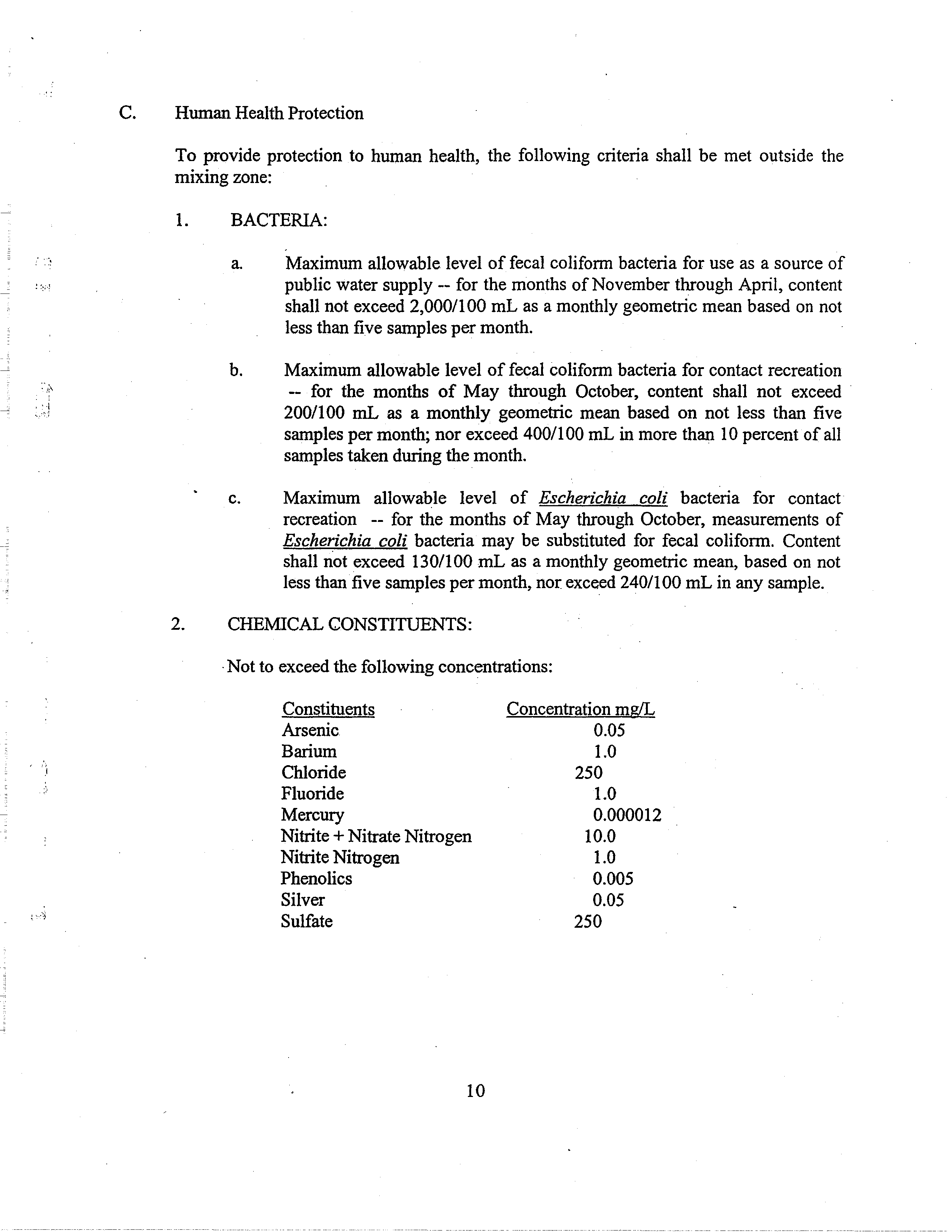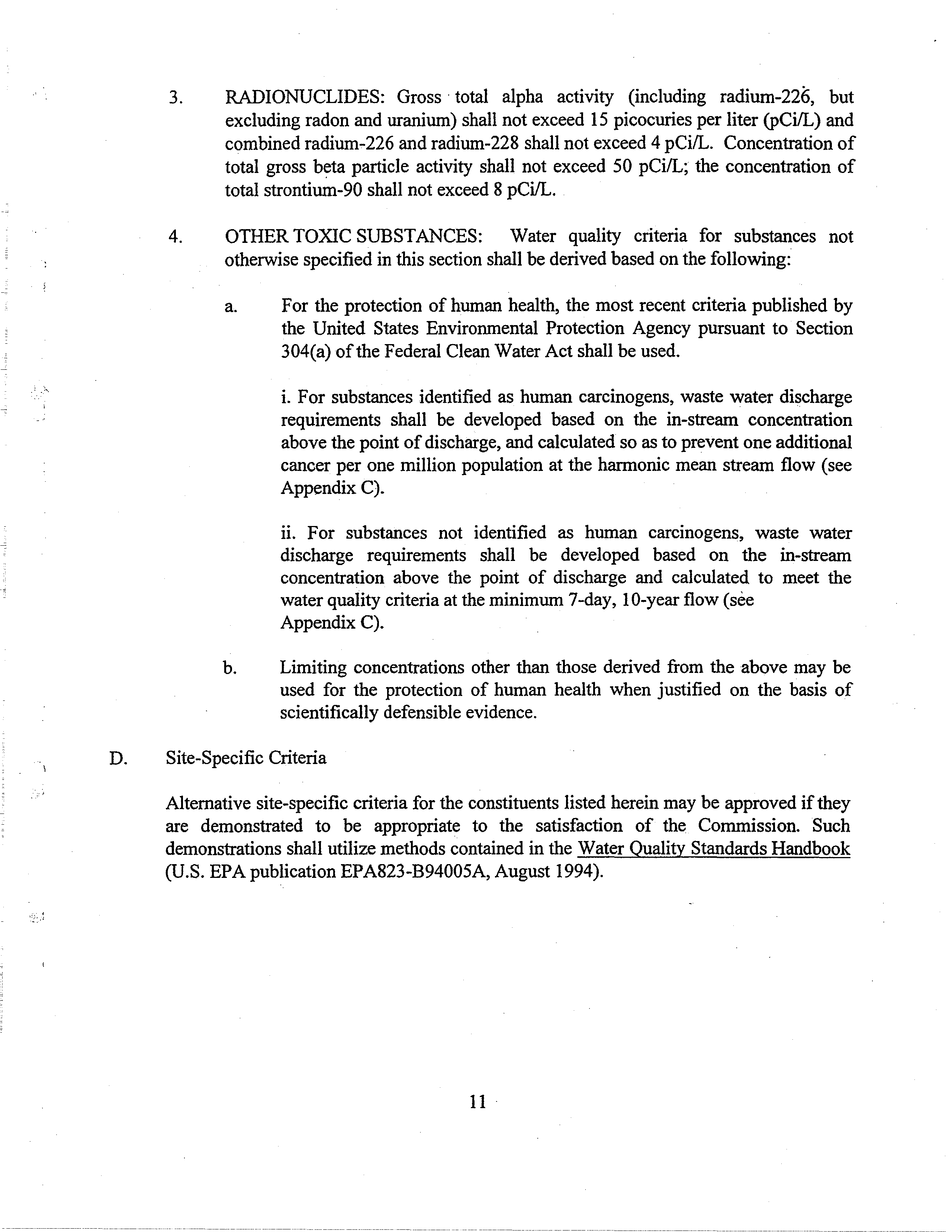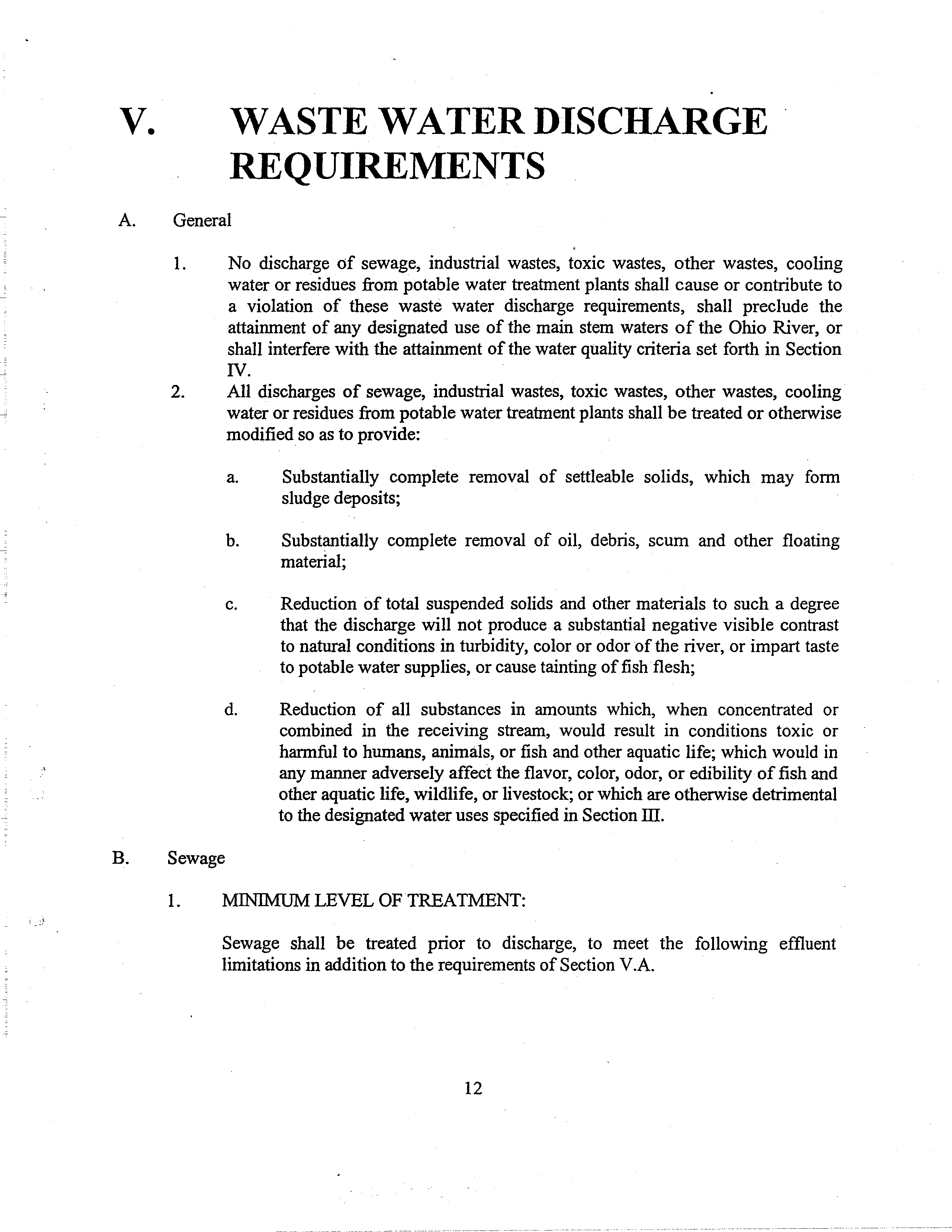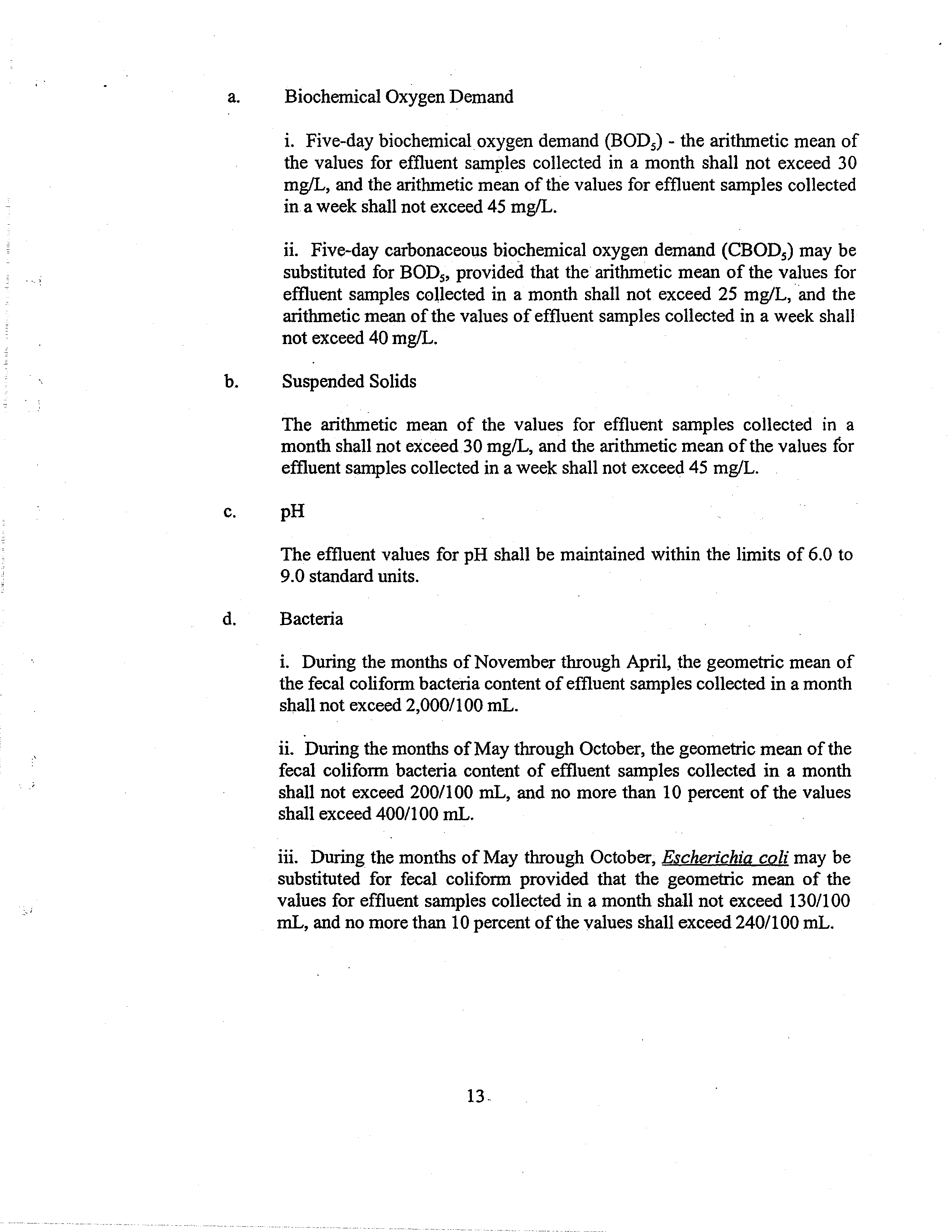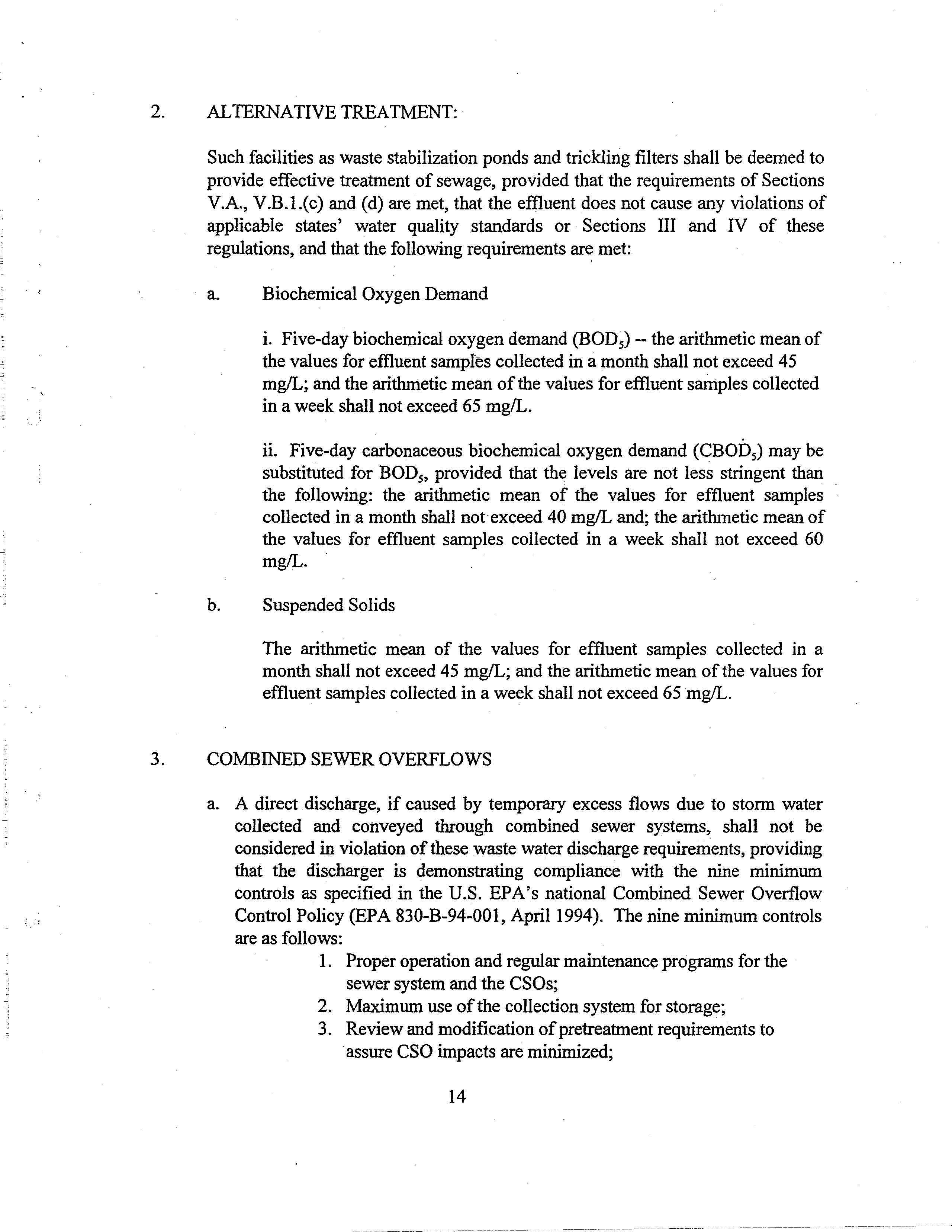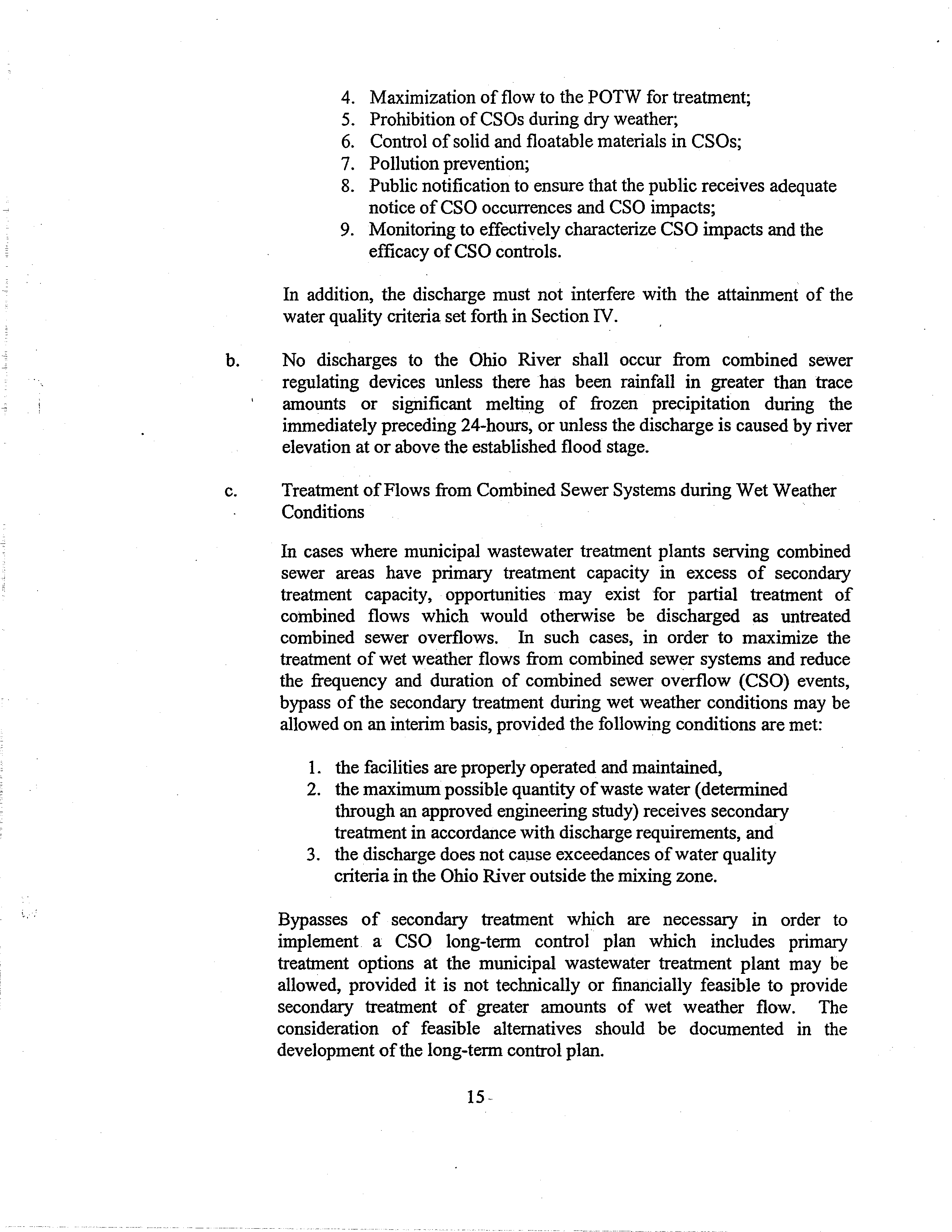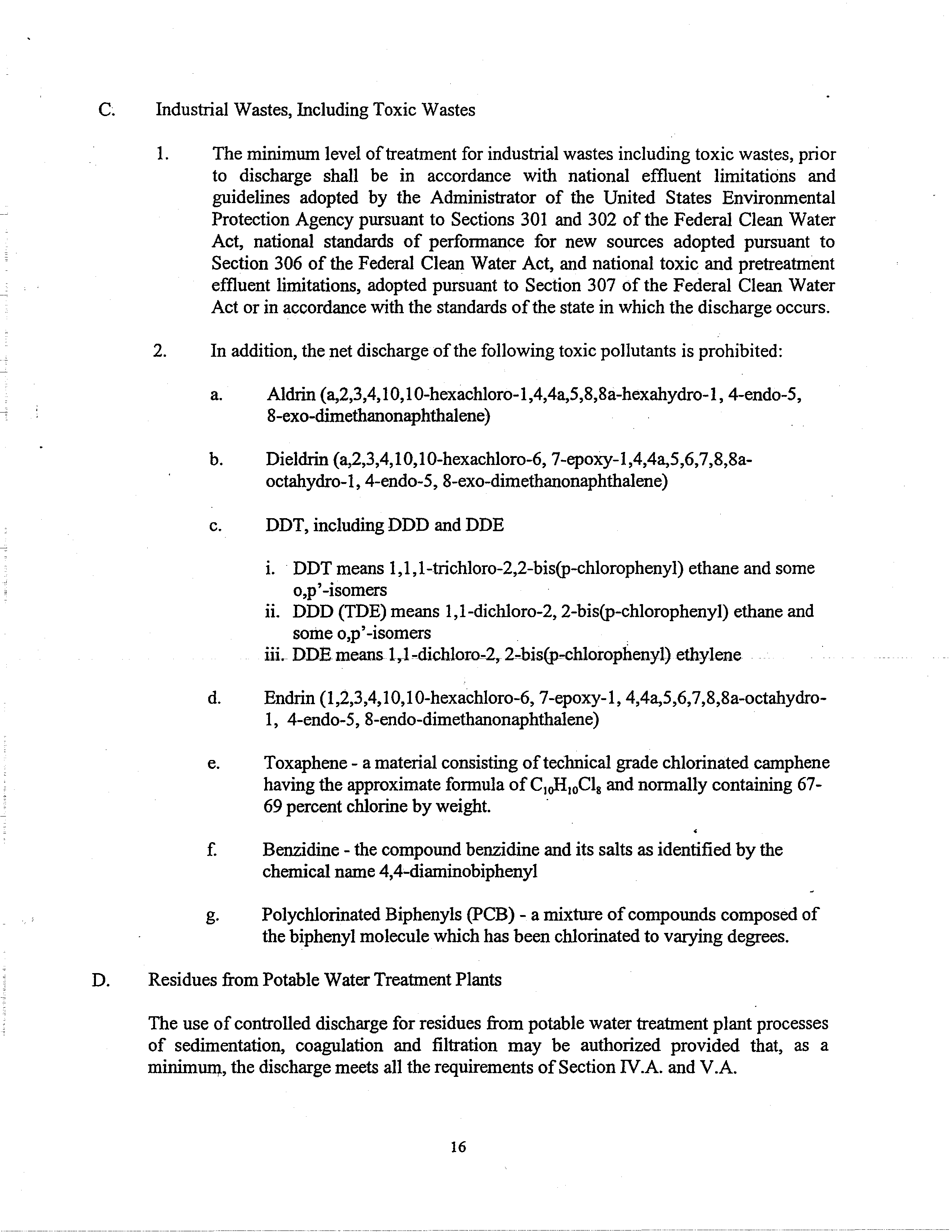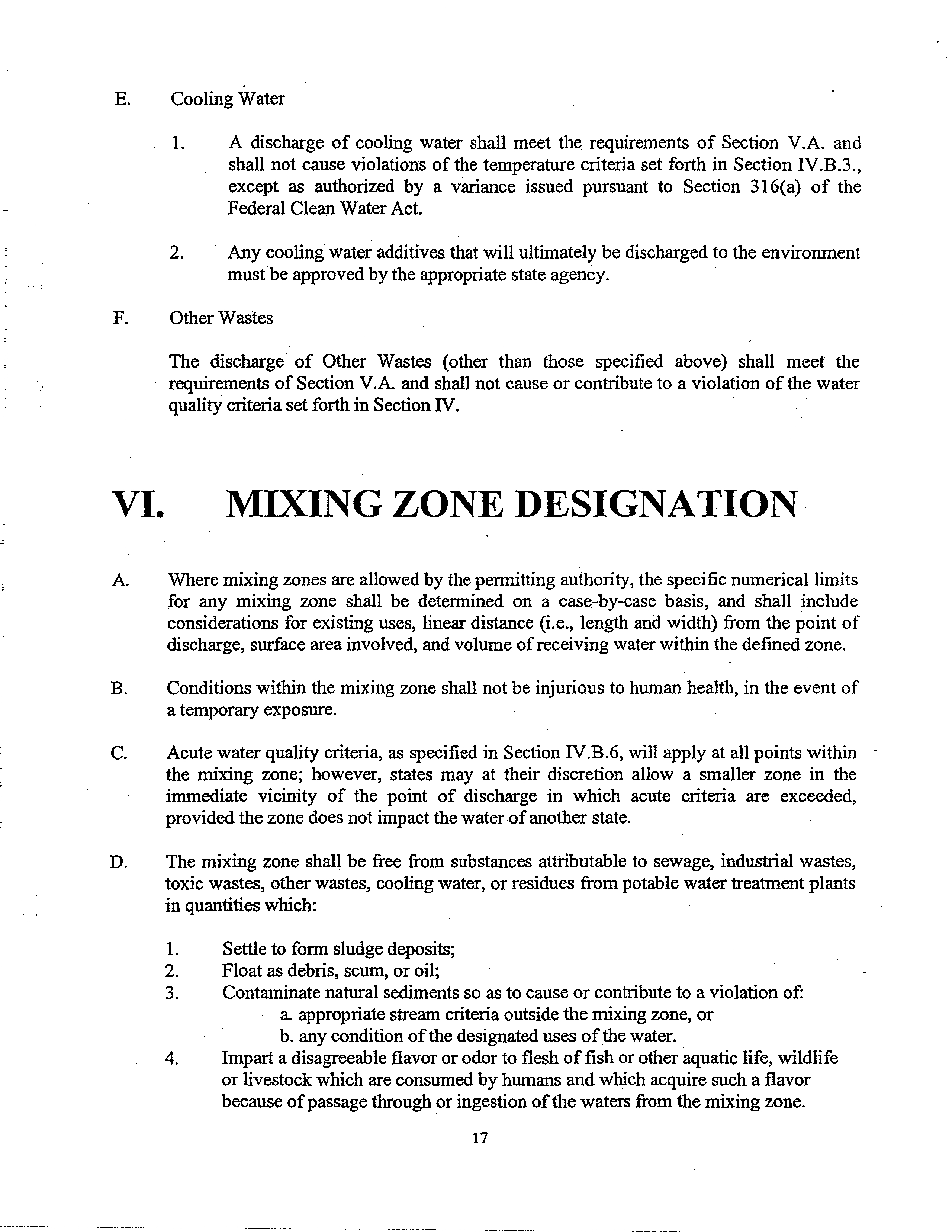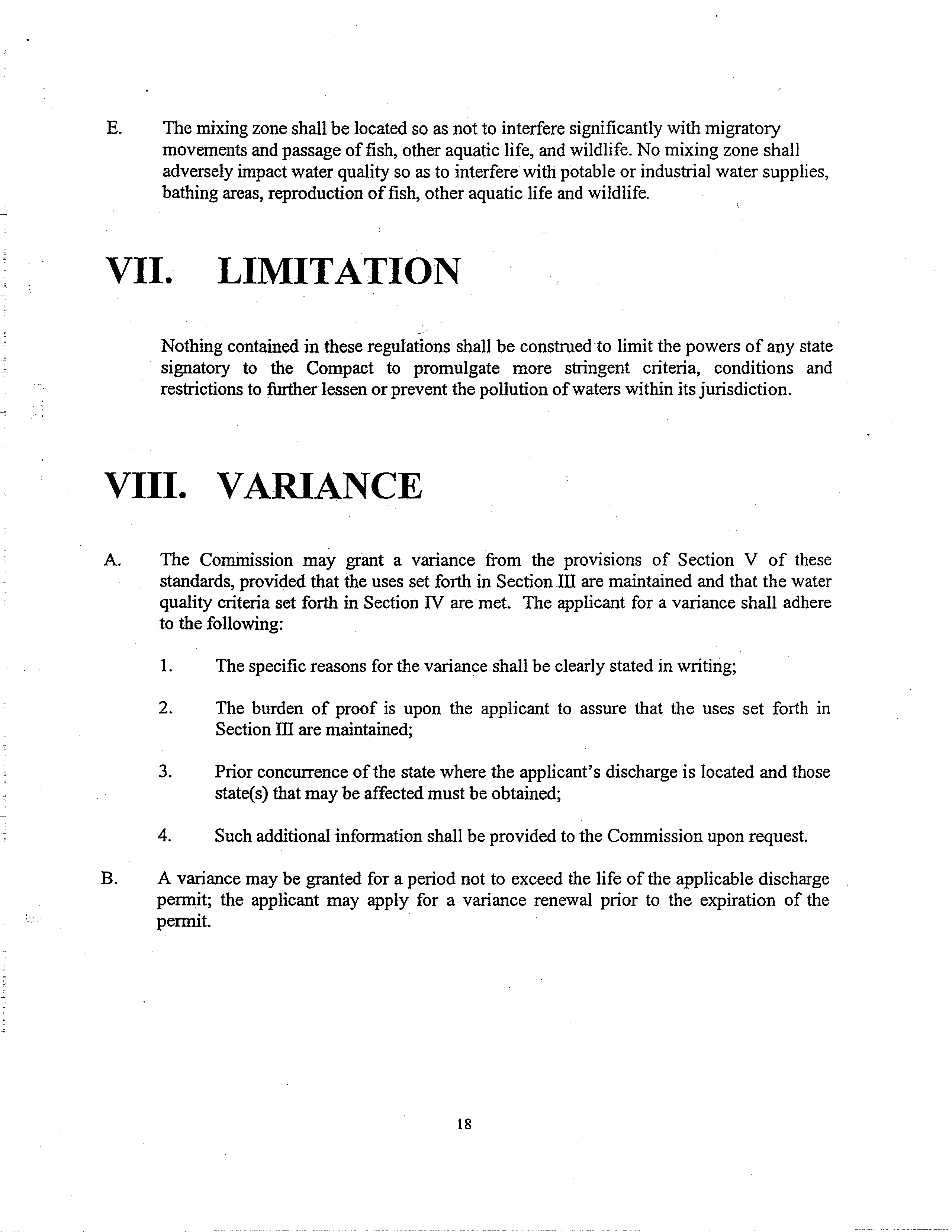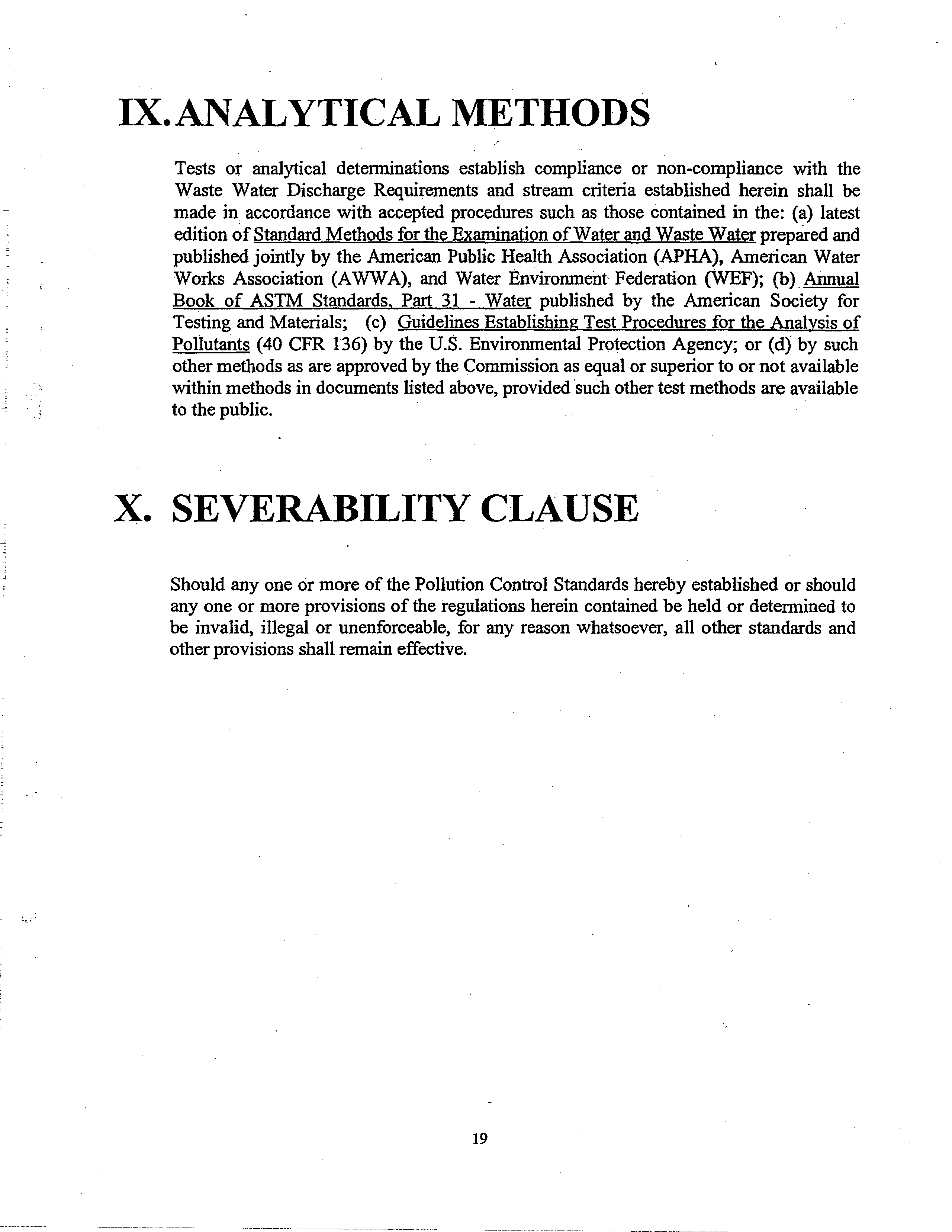Ohio River
Valley Water Sanitation Commission
POLLUTION
CONTROL
STANDARDS
for discharges to the Ohio River
2000 Revision
Notice ofRequirements
You
are hereby notified that, having consid-
ered
all the evidence presented
at public
hearings,
the
Ohio
River
Valley
Water
Sanitation Commission,
at its
regularly
held
meeting on October
12,
2000,
acting
in
accordance
with
and
pursuant
to
the
authority contained in Article VI ofthe Ohio
River
Valley Water
Sanitation
Compact,
adopted
and
promulgated, subject to revision
as changing
conditions
require,
Pollution
Control
Standards
2000
Revision
for
the
modification ortreatment ofall sewage from
municipalities
or
other
political
subdivi-
sions,
public
or
private
institutions,
corporations or watercraft, and for the modi-
fication or
treatment
of all
industrial
wastes
discharged
or
permitted
to
flow
into
the
Ohio
River from the point of confluence of
the
Allegheny and
Monongahela
Rivers
at
Pittsburgh,
Pennsylvania,
designated
as
Ohio
River
mile
point
0.0
to
Cairo
Point,
Illinois,
located
at
the
confluence
of
the
Ohio
and
Mississippi
Rivers,
and
being
981.0
miles
downstream
from
Pittsburgh,
Pennsylvania.
Under the terms and provisions of the Ohio
River
Valley
Water
Sanitation
Compact,
all
sewage
from
municipalities
or
other
political
subdivisions,
public
or
private
institutions, cor-
orations or watercrafl and
all
industrial wastes
discharged or permitted to flow into the Ohio
River will be required to be modified or
treated
to the extent specified in the standards
estab-
ished as above set forth.
To the extent that
Pollution
Control Standards
(1997
Revision),
which were
established
by
Commission action
Januaiy
9,
1997,
have
been
amended
or
restated
by
virtue
of
Pollution
Control
Standards
2000,
the
Pollution
Control
Standards
1997
Revision,
including
any
defini-
tions
and
application procedures appended to or
incorporated therein, are rescinded.
Alan H. Vicory,
Jr.
Executive Director and ChiefEngineer
I.
TABLE
OF CONTENTS
I.
AUTHORITY AND PURPOSE
1
II.
DEFINITIONS
~
ifi.
DESIGNATED USES
5
IV.
WATER QUALITY CRITERIA
5
A.
General
B.
AquaticLifeProtection
C.
Human Health Protection
~
D.
Site-Specific Criteria
~
11
V.
WASTE WATERDISCHARGE REQUIREMENTS
~..
...
..12
A.
General
B.
Sewage
~
12
C.
Industrial Wastes, Including Toxic Wastes
16
D.
Residues from Potable
Water Treatment Plants
16
E
Cooling Water
17
F.
Other Wastes
~-_~
17
VI
MIXING ZONE DESIGNATION
.~
J 7
VII.
L~TATION
_~~~18
VIII.
VARIANCE
18
IX.
ANALYTICAL
METHODS
19
X.
SEVERABILITY CLAUSE
19
APPENDIX
A
Acute
and
Chronic
Cntena Concentrations For
Total Ammonia-Nitrogen (in Mg/L) for Varying
Combinations ofpH
and
Temperature
20
APPENDIX B:
Numerical
Values ofDissolved Metals Criteria at
Specified Hardness Levels
23
APPENDIX C:
Critical Flow Values
24
APPENDIXD:
Great Lakes Water Quality Initiative Methodologies
For Development ofAquatic Life Criteria
and
Values
Methodology for Deriving Aquatic Life Criteria
25
/i
~
Ohio River Valley Water Sanitation Commission
POLLUTION CONTROL
STANDARDS
for discharges to the OhiO River
2000 Revision
I.
AUTHORITY AND
PURPOSE
The
Ohio
River Valley Water
Sanitation
Compact
(the
Compact)
was
signed
in
1948
by
the
Governors of the States ofIllinois, Indiana, Kentucky, New York,
Ohio,
Pennsylvania,
Virginia,
and
West Virginia, following
the
consent of the United
States Congress
and
enactment of the
Compact
into
law
by the legislatures ofle
eight
states.
The
Compact
created the Ohio
River
Valley Water
Sanitation
Commission
(the
Commission)
as
a
body
corporate with powers
and
duties set
forth
in
it
for
the purpose of
abating
water
pollution
within the
Compact District.
Article I of the Compact mandates that all
waters
in
the District
be placed
and
maintained
in
a
satisfactory,
sanitary
condition,
available
for
certain
beneficial
uses.
It
is
the
mission of the
Commission
to
insure
protection of these uses
and
to preserve the waters for
other
legitimate
purposes.
The Compact
grants
the Commission authority to
carry
out its mission~
Article VI states that “the
guiding
principle
of
this
Compact
shall
be
that
pollution
by
sewage
or
industrial
wastes
originating
within
a
signatory
State shall not injuriously affect the
various
uses of the interstate
waters.”
Minimum
requirements
for
the
treatment of sewage
and
industrial
waste
then
are
established in Article VI, as well
as the authority ofthe, Commission to require
higher degrees
of
treatment where they
are
determined to be necessary after investigation,,due notice, an ci: hearing.
Article VI
concludes by authorizing the Commission
to “adopt, prescribe, and promulgate rules,
regulations and standards for administering
and
enforcing the provisions of
this
article.”
Article IX of
the
Compact
grants
the Commission authonty
to
issue orders,
after mvestigation
and hearing,
for
the
purpose
of achieving compliance with its
standards.
Aiy’cotirt
of general
jurisdiction
or
any
United
States
District
Court
in
the
signatory
states
may be
used
by the
Commission in order to enforce such orders.
1
It is the policy ofthe Commission to rely on the member
states
for the
primary
enforcement of its
standards.
Each of the member states is authorized to do so
under the legislation that enabled its
membership
in
the
Compact.
Each
of the
member
states
is
authorized
to
administer
the
federal/state
National
Pollutant
Discharge
Elimination
System
(NPDES)
as
established
in
Section 402 of the Federal
Clean
Water Act.
Sections 301 (b)(1 )(C)
and
510
of the Federal
Act
require that permits issued under that system incorporate applicable standards promulgated by an
interstate
agency
wherever they
are
more
stringent
than
comparable
state or
federal
standards.
The NPDES
permits
are therefore the primary
means by which the Commission’s
Standards
are
implemented
and enforced.
These standards set forth the uses to be protected in the Ohio River (Section III),
as established in
the Compact;
establish water quality
criteria to
assure
that those uses will be
achieved (Section
IV),
and
set waste
water discharge
requirements (Section V)
needed to
attain
the water
quality
criteria. The
standards
also
recognize the
rights of individual
states to
adopt
and
apply
more
stringent regulations.
Specific waste
water
discharge
requirements
are
established
in
these regulations
and
must
be
incorporated into
discharge
permits
issued under the authority of the NPDES
or state discharge
permitting programs when they
are
more stringent than:
1)
applicable
U.S.
EPA
technology-based
effluent
guidelines
required
under
Sections
301, 304, 306,
and
307 ofthe Federal Clean Water Act, or
2)
any
state treatment
requirements,
effluent, standards,
or
water quality-based
effluent
limits.
In
the absence of promulgated
Federal
effluent
guidelines pursuant
to Sections
301,
304,
306,
and
307’ of
the Clean Water Act, the Compact signatory states
have the responsibility to establish
effluent
limitations
to
be
included
in
any
discharge
permit,
consistent
with
the
standards
contained herein using Best Professional Judgment on a case-by-case basis~
II.
DEFINITIONS
A.
“Acute
Criteria”
means
the
highest
concentrations
of
toxic
substances
to
which
organisms
can
be
exposed
for
a
brief period of
time
(as
measured by
approved
short-
term exposure tests) without causing mortality or other unacceptable effects.
B.’
“Biological Integrity” means the ability of an aquatic
ecosystem to support
and
maintain
a balanced,
integrated,
adaptive community of organisms having
a species
composition,
diversity,
and
functional
organization
comparable
to
those
best
attainable
given
ecoregional attributes
and
the modified habitattypes ofthe river.
2
C.
“Chronic
Criteria”
means
the
highest
concentrations
of
toxic
substances
to
which
organisms can be exposed indefinitely without causing long-term harmful effects on
growth
and/or
reproduction
or
other
unacceptable
effects
(as
measured
by
approved
long-term
exposure tests).
D.
“Combined Sewer Overflow” means a discharge from a sewer system designed to convey
sanitary
waste
waters
and
storm
water
through
a
single-pipe
system
to
a
treatment
facility, at a point in the system prior to the treatment facility.
E.
“Compact,” as used in these regulations, means the Ohio River Valley Water
Sanitation
Compact
and
is
an
agreement
entered
into by
and
between the states of Indiana, West
Virginia, Ohio, New York, Illinois, Kentucky, Pennsylvania, and Virginia, which pledges
each to the other ofthe signatory states faithful cooperation in the control ofexisting and
future pollution of the waters
in the Ohio River Basin.
This Compact
created
the Ohio
RiverValley Water Sanitation Commission.
F.
“Cooling Water” means water used as a heat transfermedium for once-through cooling or
cooling
tower
blow
down
to
which
no
industrial
wastes, toxic
wastes,
residues
from
potable water treatment plants, untreated sewage, or other wastes, exclusive ofantifouling
agents approved by the appropriate regulatory agencies, are added prior to discharge.
G.
“Contact Recreation” means recreational
activities where the human body may come
in
direct contactwith water ofthe Ohio River.
H.
“Early
Life
Stages” of fish
means the pre-hatch
embryonic
period, the post-hatch
free
embryo or yolk-sac
fly, and the larval period, during which the organism feeds.
Juvenile
fish, which are anatomically rather similar to adults, are not considered an early life stage.
“Industrial
Wastes”
means
any
liquid,
gaseous,
solid
materials or
waste substances
or
combination
thereof
other
than
cooling
water
as
herein
defined,
resulting
from
any
process
or operation
inclUding
storage and
transportation, ,manufacturing,
commercial,
agricultural, and government operations.
J.
“Mixing Zone” means that portion of thewater body receiving a discharge where effluent
and receiving waters are not totally mixed and
uniform with the result that the zone is not
representative
of the
receiving
waters
and
may
not
meet
all
ambient
water
quality
standards
or
other
requirements
of
any
signatory
state
applicable
to
the
particular
receiving waters.
K.
“Net Discharge” is determined by excluding the amount ofpollution in intake water when
determining the quality ofa discharge if both the intake and discharge are from’ and to the
same body ofwater.
3-
L.
“96 hour LC50” as used in these regulations, means the concentration of a substance that
kills 50 percent ofthe test organisms within 96 hours. The test organisms shall be
representative important species indigenous to the Ohio River or standard test organisms.
M.
The “Ohio River,” as used in these regulations,
extends from the point ofconfluence of
the Allegheny and
Monongahela rivers
at Pittsburgh, Pennsylvania, designated
as Ohio
River mile point
0.0
to
Cairo Point,
Illinois, located
at the confluence of the• Ohio
and
Mississippi Rivers, 981.0 miles downstream from Pittsburgh.
N.
“Ohio
River
Valley Water
Sanitation
Commission”
(the
Commission)
means
a body
corporate created by authority
of
the Compact and is the operating agency established to
implement the ‘Compact.
It
consists ofthree representatives of each signatory
state and
three reprósentatives ofthe federal government.
0.
“Other Wastes”means any waste other than sewage, cooling water, residues from potable
water treatment plants, industrial wastes or toxic wastes which, if discharged to the Ohio
River,
could cause or ‘contribute to
any
violations ofthese regulations, or of any water
quality
standards of any signatory state, ‘or which may be
deleteriOus
to the designated
uses.
Other
wastes
include,
but
are
not
limited
to:
garbage,
refuse,
decayed
wood,
sawdust,
shavings,
bark and
other wood debris
and
residues
resulting
from
secondary
processing,
sand,
lime
cinders,
ashes,
offal,
night
soil,
silt,
oil,
tar,
dyestuffs,
acids,
‘chemicals, heat or other materiais~andsubstances not sewage or industrial
wastes which
may cause or might reasonably be expected to cause or contribute to the pollution ofthe
Ohio River.
P.
“Persistent
Substances”
means
those
substances
that
have
a
half-life
for
degradation
under natural environmental conditions of more than four days.
All other substances are
non-persistent.
Q.
“Pollution”
means
the
human-made
or
human-induced
alteration
of
the
chemical,
physical, biological and radiological integrity ofthewaters ofthe Ohio River.
R.
“Representative Aquatic Species” means those
species of aquatic
,
life whose protection
and propagation will assure the sustained presence of’a balanced indigenous
community.
Such
species are representative
in the sense that
maintenance of suitable water quality
conditions
will assure
the overall
protection
and
sustain
propagation’ of the balanced,
indigenous community.
S.
“Residues from
Potable
Water
Treatment
Plants” means those wastes
emanating
from
processes used in waterpurification. Such processes may include sedimentation, chemical
coagulation, filtration, iron and manganese removal, softening and disinfection.
4
T.
“Sewage” means water-carried human or animal wastes from such sources as residences;
industrial,
commercial,
or government
establishments;
public
or private
institutions; or
other places. For the purposes ofthese standards, the
admixture
ofsewage with industrial
wastes,
toxic wastes, or other wastes, shall be subject to treatment requirements for those
types
of wastes, but shall also be regarded as sewage.
U.
“Substantially
Complete
Removal”
means
removal
to
the
lowest
practicable
level
attainable
with current
technology.
V.
“Toxic Wastes” means wastes
containing
substances or
combinations of substances
in
concentrations which might reasonably
be
expected
to
cause
death, disease, behavioral
abnormalities,
genetic
mutations,
physiological
malfunctions,
including
those
in
reproduction, or physical deformations
in
fish,
other aquatic life,
wildlife,
livestock, or
humans.
W.
“Waste Water”means sewage and/or
industrial wastes as herein defined.
III.
DESIGNATED
USES
The
Ohio
River, as
hereinbefore defined, has been designated
by
the Compact as available for
safe
and
satisfactory
use
as
public
and
industrial
water
supplies
after
reasonable
treatment,
suitable for recreational usage,
capable of maintaining
fish and other aquatic life, and
adaptable
to such other uses as may be legitimate.
It is the purpose ofthese Pollution
Control Standards to
safeguard the waters of the Ohio
River for these designated uses. No degradation ofthe water
quality
of the
Ohio
River that
would
interfere with or become injurious to these uses shall be
permitted.
IV.
WATER QUALITY
CRITERIA
A.
General
The
minimum conditions
which the waste water discharge requirements (Section V) are
intended to achieve in the receiving waters
outside
the mixing zone are as follows:
1.
Freedom
from
anything
that
will
settle
to
form
objectionable
sludge
deposits
which interfere with designated water uses.
2.
Freedom from floating
debris,
scum,
oil
and other floating
material
in
amounts
sufficient to be unsightly or deleterious.
5-
/
3.
Freedom from materials producing color or odors to such a degree as to create
unaesthetic conditions or a nuisance.
4.
Freedom from substances in concentrationswhich are toxic or
harmful
to humans,
animals, or fish
and other aquatic
life;
which
would
in
any
manner adversely
affect the flavor, color, odor, or edibility of fish and other aquatic life, wildlife, or
livestock, or which
are otherwise detnmental to
the
designated uses specified
in
Section III.
B.
Aquatic Life Protection
To
provide protection of warm water aquatic life habitats,
the following criteria shall be
met outside the mixing zone:
1.
BIOLOGICAL:
The biological
integrity of the Ohio River shall be protected and
preserved.
2.
DISSOLVED OXYGEN: The average concentration shall be at least 5.0 mgfL for
each calendar
day; the minimum concentration
shall not be
less
than 4.0
mgfL.
During the
April
15-June
15
spawning season, a minimum concentration of
5.0
mg/L shall be maintained at
all times.
3.
TEMPERATURE: Allowable stream temperatures are:
Month/Date
January
1-31
February
1-29
March 1-15
March
16-31
April 1-15
April 16-30
May 1-15
May 16-31
June 1-15
June 16-30
July 1-31
August 1-31
September 1-15
September 16-30
October 1-15
October 16-31
November 1-30
December
1-31
Period Average
45°F 7.2°C
45
7.2
51
10.6
54
12.2
58
14.4
64
17.8
68
20.0
75
23.9
80
26.7
83
28.3
84
28.9
84
28.9
84
28.9,
82
27.8
77
25.0
72
22.2
67
19.4
52
11.1
Instantaneous Maximum
50°F 10.0°C
50
10.0
56
13.3
59
15.0
64
17.8
69
20.6
73
22.8
80
26.7
85
29.4
87
30.6
89
31.7
89
31.7
87
30.6
86
30.0
82
27.8
77
25.0
72
22.2
57
13.9
6
4.
pH: No value below 6.0 standard units nor above 9.0 standard units.
5.
AMMONIA
a.
Acute Criterion
Concentration:
The one-hour
average
concentration of total
ammonia-nitrogen
(mgJL)
shall not exceed, more than once every three years on
the average, the ACC (acute criterion) calculated using the following equation:
ACC=
0.411
1
+
10
(7.204-pH)
+
58.4
I
+
10
(pH-7.204)
b.
Chronic Criterion
Concentration:
The
30-day
average concentration of total
ammonia-nitrogen (in mg/L)
shall not exceed, more than once every three years,
theCCC (chronic criterion) calculated using
the following equations:
i.
VThen fish early life stages are present (fromMarch 1 to October 31):
T
=
Temperature,
°C
Note:
For the above equation, multiply
the parenthetical equation by
2.85
when
temperature
is
less
than
or
equal
to
14.51°C.
When
temperature
is
greater than 14.51°C, multiply the
parenthetical
equationby (1.45
*
1
0(0.028*(25T)).
ii.
When fish early life stages are absent (from
November
1 to the last day of
February
CCC
=
(0.0577
+ 10
(7.68~~
Where:
+
2.487
1
+
10
~~~7688~
)
*(
1.45
*
100028*
(25- (MAX
IT Ok 71)))
T
=
Temperature, °C
Note:
Forthe above equation, the last term should be
10(0.028 (25-T)) for
all temperatures greater than 7°C.
When temperatures are 7°Cor
less, the
last term in the equation should be
10(0.028(257~
or
1
0(0i0~
CCC
=
(
0.0577
+
10
(7.688.pH)
Where:
+
2.487
1
+ 10
(pl-7.688)
)
*MJN~2
85
OR(1
45*
10~028
*(25T))
7
iii.
In addition, the highest four-day average withiri th~
30-day period
should not exceed
2.5
times the chronic criterion.
Acute and chronic criteria concentrations for total ammonia-nitrogen (in mg/L) or
different combinationsofpH and temperature are shown m Appendix A
6.
CHEMICAL CONSTITUENTS:
a.
Not to.exceed the following concentrations:
b.
For constituents
with
criteria’ dependent
upon
water
hardness,
dissolved’
metals acute aquatic life criteria shall be calculated~asthe total recoverable
acute
criteria multiplied
by
the
conversion; factoraccording
to
the table
‘below.
,
c
For constituents
with
cntena
dependent
upon
water hardness,
dissolved
metals
chromc
aquatic
life
entena
shall
be
calculated
as
the
total
recoverable chronic criterion multiplied by the conversion factor according
to the following table.
Concentration
-
Coucentiation (~ig/L)
arsenic ~cussoiveu~
Chromium (V1)(dissolved)
Cyanide (free)
Mercury (dissolved)
Selenium (total)
150
11
5.2
0.77
5
340
16
22.
1.4
20
Acute Cnte~on
-
Cons’ersionFactor
--
-
(~g/L)~
-
-
CádtniUfli
Chromium (Ill~
‘COpper’
Lead
Nickel
Silver
Zinc
e~°~81~”
Hard+3.7256)
Hard)4.7OO~’
~
Hard)~1.46O)
Hard)+2.255)
1 136672_~ln(Hard)*00418381
0.960~’
1.46203_Iin(Hard)*O.1457121
0.998
0.850
0.978
e0~7~”
HanI).632)
llard)4~.884)
8
d.
Concentrations for metals
are dissolved
(except
selenium,
which
is
total
recoverable),
unless
it
can
be
demonstrated
to
the
satisfaction
of the
Commission
and
its
member
states,
that
a
more
appropnate
analytical
technique is available which provides a measurement ofthat portion ofthe
metal present which causes toxicity to aquatic life.
e.
Waste
water
discharge
requirements
for
these
constituents
shall
be
expressed as total recoverable limits, and shall be based
on the dissolved
aquatic life criteria, the
appropriate translators (as listed
in Appendix
B),
the
in-stream
concentration
upstream of the point of discharge, and
the
minimum
7-day,
10-year
stream
flow
as
contained
in
Appendix~C.
Translators,
other than those
listed
in Appendix
B,
may
be used after a
successful
demonstration
to
the
Commission
and
its
member
states.
Criteria for cadmium, trivalent chromium,
copper,
lead, nickel,
silver and
zinc at specified hardness values are listed in Appendix C.
7.
OThER
TOXIC SUBSTANCES:
Water
quality
criteria for substances
not otherwise specified
in this section shall
be derived based on the following:
a.
For the Protection of Aquatic Life, methodologies set forth in U.S.
EPA’s
Final Water Quality Guidance for the Great Lakes System, adopted in the
Federal Register, March 23,
1995, shall be used (see Appendix D).
b.
Limiting
concentrations other than those derived from the, above may be
used
for
the
protection
of
aquatic
life
when
justified
on
the
basis
of
scientifically defensible evidence.
Total
Recoverable
Dissoh ed Criterion
Constituent
Chronic Criterion
Corn ersion Factor
(j~tgIL)
~aamium
Chromium (trivalent)
Copper
Lead
Nickel
Zinc
e’’
—
e~°~819~’~
Hard)+O.6848)
Hard)-i.702)
Hard)-4.705)
e~°~8460~
Hard)+O.0584)
Hard)+O.884)
1 .101672_~In(Hard)*O.0418381
0.860
0.960
‘
1.46203.~~ln(Hard)*0.145712
0.997
0.986
9-
C.
Human Health Protection
To provide protection to human
health,
the
following criteria shall be met
outside
the
mixing zone:
BACTERIA:
a.
Maximum allowable level
of fecal coliform bacteria for use as a source of
public water supply
--
for the months of November through April,
content
shall not exceed 2,000/100mL
as a
monthly geometric mean based
on
not
less than five samples per month.
b.
Maximum allowable
level
of
fecal colifonn
bacteria
for contact recreation
--
for
the
months
of May
through
October,
content
shall
not
exceed
200/100
mL
as
a
monthly
geometric mean
based
on
not
less
than five
samples per month;
nor exceed 400/100 mL in more than
10 percent ofall
samples taken during the month.
c.
Maximum allowable
level
of
Escherichia
coli
bacteria
for
contact
recreation
--
for the months of May through October,
measurements of
Escherichia
coli
bacteria
may
be
substituted
for fecal
coliform.
Content
shall not
exceed
130/100 mL as a monthly
geometric mean, based on not
less than five samples per month, nor exceed 240/100 mL in any sample.
2.
CHEMICAL CONSTITUENTS:
Not to exceed the following concentrations:
Constituents
Arsenic
Barium
Chloride
Fluoride
Mercury
Nitrite
+
Nitrate Nitrogen
Nitrite
Nitrogen
Phenolics
Silver
Sulfate
Concentration
mg/L
0.05
1.0
250
1.0
0.000012
10.0
1.0
0.005
0.05
250
10
3.
RADIONUCLIDES:
Gross ‘total
alpha
activity
(including
radium-22~, but
excluding radon and uranium) shall not exceed
15 picocuries per liter (pCifL) and
combined radium-226
and radium-228 shall not exceed
4 pCi/L.
Concentration of
total
gross beta
particle
activity
shall not
exceed
50 pCiIL;
the concentration
of
total strontium-90 shall not exceed
8 pCi/L.
4.
OTHERTOXIC SUBSTANCES:
Water
quality
criteria
for
substances
not
otherwise specified in this section shall be derived based on the following:
a.
For the protection of human health, the most recent criteria published by
the United States Environmental Protection Agency pursuant to Section
304(a) ofthe Federal Clean Water Act shall be used.
i. For substances
identified as human carcinogens, waste water discharge
requirements
shall
be
developed
based
on
the
in-stream
concentration
above the point ofdischarge,
and
calculated so as to prevent one additional
cancer
per one million population at the
harmonic mean
stream
flow (see
Appendix C).
ii.
For
substances
not
identified
as
human
carcinogens,
waste
water
discharge
requirements
shall
be
developed
based
on
the
in-stream
concentration
above
the
point
of discharge
and
calculated
to
meet
the
water quality criteria at the minimum 7-day,
10-year flow (see
Appendix C).
b.
Limiting
concentrations
other
than
those derived
from the above may be
used for
the
protection
of human
health
when justified
on
the basis
of
scientifically defensible evidence.
D.
Site-Specific Criteria
Alternative site-specific criteria for the constituents listed herein may be approved if they
are
demonstrated
to
be
appropriate
to
the
satisfaction
of
the
Commission.
Such
demonstrations shall utilize methods contained in the Water Quality Standards Handbook
(U.S. EPA publication EPA823-B94005A, August 1994).
11
V.
WASTE WATER DISCHARGE’
REQUIREMENTS
A.
General
No
discharge of sewage,
industrial
wastes,
toxic
wastes,
other wastes,
cooling
water or residues from potable water treatment plants
shall cause or contribute to
a
violation
of
these
waste
water
discharge
requirements,
shall
preclude
the
attainment of
any
designated use of the main stem waters of the Ohio
River, or
shall interfere with the attainment of the water quality criteria set
forth in
Section
IV.
2.
All
discharges of sewage,
industrial wastes, toxic
wastes,
other wastes,
cooling
water or residues from potable water treatment plants shall be treated or otherwise
modified so as to provide:
a.
Substantially
complete
removal
of
settleable
solids,
which
may
form
sludge deposits;
b.
Substantially
complete
removal of
oil,
debris,
scum
and
other
floating
material;
c.
Reduction of total
suspended solids
and
other materials
to such a
degree
that
the discharge will not
produce a substantial
negative visible
contrast
to natural conditions in turbidity, color or odor ‘ofthe river, or impart
taste
to potable water supplies, or cause tainting offish flesh;
d.
Reduction
of
all
substances
in
amounts
which,
when
concentrated
or
combined
in
the
receiving
stream,
would
result
in
conditions
toxic
or
harmful to humans,
animals, or fish and other aquatic life;
which would
in
any
manner adversely affect the flavor, color, odor, or edibility offish and
other aquatic life, wildlife, or livestock; or which are otherwise detrimental
to the designated water uses specified in Section ifi.
B.
Sewage
MINIMUM
LEVEL OF TREATMENT:
Sewage
shall
be
treated
prior
to
discharge,
to
meet
the
following
effluent
limitations in addition to the requirements of Section V.A.
12
a.
Biochemical Oxygen Demand
i.
Five-day biochemical oxygen demand (BOD5)
-
the
arithmetic
mean of
the values for
effluent
samples collected
in
a month shall
not
exceed
30
mg/L,
and the arithmetic mean ofthe values for effluent samples collected
in’ a week shall not exceed 45 mg/L.
ii.
Five-day carbonaceous biochemical oxygen demand (CBOD5) may be
substituted
for BOD5,
provided that
the arithmetic mean ofthe values for
effluent samples
collected in
a
month shall not
exceed
25
mg/L,
and
the
arithmetic mean ofthe values of effluent samples collected in a week
shall
not exceed 40 mg/L.
b.
Suspended Solids
The
arithmetic
mean
of the
values
for
effluent
samples
collected
in
a
month shall not exceed 30 mg/L,
and the arithmetic mean of the values (or
effluent samples collected
in a week shall not exceed
45
mg/L.
c.
pH
The effluent values for pH shall be maintained within the limits of 6.0 to
9.0 standard units.
d.
Bacteria
i.
During the months ofNovember through April,
the geometric mean of
the fecal coliform bacteria content ofeffluent
samples collected in a month
shall not exceed 2,000/100 mL.
ii.
During the months ofMay through October, the geometric mean ofthe
fecal
coliform
bacteria content
of effluent samples collected
in
a
month
shall not exceed
200/100 mL, and no
more than
10
percent ofthe values
shall exceed 400/100 mL.
iii.
During the months ofMay through October,
Escherichia cpu
may be
substituted
for
fecal
coliform
provided
that
the
geometric mean of the
values for effluent samples collected
in a month shall not exceed 130/100
mL, and no more than 10 percent ofthe values shall exceed 240/100 mL.
13..
2.
ALTERNATIVE
TREATMENT:’
Such facilities as waste stabilization ponds and trickling filters shall be deemed to
provide effective treatment ofsewage, provided that the
requirements of Sections
V.A., V.B.1 .(c) and
(d) are met, that the effluent does not cause any
violations of
applicable
states’
water
quality
standards
or
Sections
III
and
IV
of
these
regulations, and that the following requirements are met:
a.
Biochemical Oxygen Demand
i.
Five-day biochemical oxygen demand (BOD5)
--
the arithmetic mean of
the values for effluent samples collected in a month shall not exceed 45
mg/L; and the arithmetic mean ofthe values for effluent samples collected
in a week shall not exceed 65 mg/L.
ii.
Five-day carbonaceous biochemical oxygen demand (CBOD5)
may be
substituted for BOD5,
provided that
the levels
are not
less
stringent than
the
following:
the
arithmetic
mean
of the
values
for
effluent
samples
collected in a month shall not exceed 40 mgfL and; the arithmetic mean of
the
values for effluent
samples collected
in
a week
shall not
exceed
60
mgfL.
b.
Suspended Solids
The
arithmetic
mean of the
values
for
effluent
samples
collected
in
a
month shall not exceed 45
mg/L;
and the arithmetic mean ofthe values for
effluent samples collected in a week shall not exceed
65
mg/L.
3.
COMBINED SEWER OVERFLOWS
a.
A direct
discharge, if caused
by temporary
excess
flows due
to
storm
water
collected
and
conveyed
through
combined
sewer
systems,
shall
not
be
considered in violation ofthese waste water discharge requirements, providing
that
the
discharger
is
demonstrating
compliance
with
the
nine
minimum
controls as specified
in the
U.S.
EPA’s
national Combined
Sewer
Overflow
Control Policy (EPA 830-B-94-00l, April
1994).
The nine minimum controls
are as
follows:
1.
Proper operation and regular maintenance programs for the
sewer system
and the CSOs;
2.
Maximum use ofthe collection system for storage;
3.
Review and modification ofpretreatment requirements to
assure
CSO impacts are
minimized;
14
4.
Maximization of flowto the POTW for treatment;
5.
Prohibition ofCSOs during dry weather;
6.
Control of solid and floatable materials in CSOs;
7.
Pollution prevention;
8.
Public notification to ensure that the public receives adequate
notice ofCSO occurrences and CSO
impacts;
9.
Monitoring to effectively characterize CSO impacts and the
efficacy ofCSO controls.
In addition,
the
discharge must not
interfere with
the attainment of the
water quality criteria set forth in Section IV.
b.
No
discharges
to
the
Ohio
River
shall
occur
from
combined
sewer
regulating
devices
unless
there
‘has
been
rainfall
in
greater
than
‘trace
amounts
or
significant
melting
of
frozen
precipitation
during
the
immediately preceding 24-hours, or unless the discharge is caused by river
elevation at or above the established flood
stage.
c.
Treatment ofFlows from Combined Sewer Systems during Wet Weather
Conditions
,
In cases
where
municipal
wastewater
treatment plants
serving
combined
sewer
areas
have
primary
treatment
capacity
in
excess
of
secondary
treatment
capacity,
opportunities
may
exist
for
partial
treatment
of
combined
flows
which
would
otherwise
be
discharged
as
untreated
combined
sewer
overflows.
In
such
cases,
in
order
to
maximize
the
treatment ofwet weather flows from combined sewer systems and reduce
the
frequency and
duration of combined
sewer
overflow
(CSO)
events,
bypass ofthe secondary treatment during
wet weather conditions may be
allowed on an interim basis, provided the following conditions are met:
1.
the facilities are properly operated and maintained,
2.
the maximum possible quantity ofwaste water (determined
through an approved engineering study) receives secondary
treatment in accordance with discharge requirements, and
3.
the discharge does not cause exceedances of water quality
criteria in the Ohio River outside the mixing zone.
Bypasses
of
secondary
treatment
which
are
necessary
in
order
to
implement
a
CSO
long-term
control
plan
which
includes
primary
treatment
options
at
the
municipal
wastewater
treatment
plant
may
be
allowed, provided
it is
not
technically or
financially
feasible
to
provide
secondary
treatment
of
greater
amounts
of
wet
weather
flow.
The
consideration
of
feasible
alternatives
should
be
documented
in
the
development ofthe long-term control plan.
15
C.
Industrial Wastes, Including Toxic Wastes
The
minimum level oftreatment for industrial wastes including toxic wastes, prior
to
discharge
shall
be
in
accordance
with
national
effluent
limitations
and
guidelines
adopted
by
the
Administrator
of the
United
States
Environmental
Protection Agency pursuant to
Sections
301
and
302 of the Federal Clean Water
Act,
national
standards
of performance
for
new
sources
adopted
pursuant
to
Section 306 of the Federal
Clean Water Act, and national toxic
and pretreatment
effluent limitations, adopted pursuant to
Section
307 of the Federal Clean Water
Act or in accordance with the standards of the state in which the discharge occurs.
2.
In addition, the net discharge ofthe following toxic pollutants
is prohibited:
a.
Aidrin (a,2,3,4,l 0,1 0-hexachloro- 1 ,4,4a,5,8,8a-hexahydro- 1, 4-endo-5,
8-exo-dimethanonaphthalene)
b.
Dieldrin (a,2,3,4, 10,1 0-hexachloro-6, 7-epoxy-l,4,4a,5,6,7,8,8a-
octahydro-l, 4-endo-5, 8-exo-dimethanonaphthalene)
c.
DDT, including ~DDDand DDE
i.
DDT means l,1,1-trichloro-2,2-bis(p-chlorophenyl)ethane and some
o,p’-isomers
ii.
DDD (TDE) means
1,1 -dichloro-2, 2-bis(p-chlorophenyl) ethane and
some o,p’-isomers
iii~
DDE.means I,i4ichioLro~2,
2~bis(p-ch1orophenyI)ethylene~~
d.
Endrin (1,2,3,4,10,10-hexaChloro-6, 7-epoxy-i, 4,4a,5,6,7,8,8a-octahydro-
1,
4-endo-5, 8-endo-dimethanonaphthalene)
e.
Toxaphene
-
a material consisting ofteôlmical grade chlorinated camphene
having the approximate formulaofC10H10C18 and normally containing 67-
69 percent chlorine by weight.
f.
Benzidine
-
the compound benzidine and its salts as identified by the
chemical name 4,4-diaminobiphenyl
g.
Polychlorinated Biphenyls (PCB)
-
a mixture ofcompounds composed of
the biphenyl molecule which has been chlorinated to varying degrees.
D.
Residues from Potable Water Treatment Plants
The use ofcontrolled discharge for residues from potable water treatment plant processes
of
sedimentation,
coagulation
and
filtration
may
be
authorized
provided
that,
as
a
minimum, the discharge meets all therequirements of Section IV.A. and V.A.
16
E.
Cooling Water
1.
A
discharge of cooling
water shall meet
the
requirements of Section
V.A.
and
shall not cause violations of the temperature criteria set forth in
Section
IV.B.3.,
except
as
authorized
by
a
variance
issued
pursuant
to
Section
316(a)
of
the
Federal Clean Water Act.
2.
Any cooling water additives that will ultimately be discharged to the environment
must be approved by the appropriate state agency.
F.
Other Wastes
The
discharge
of
Other
Wastes
(other
than
those
specified
above)
shall
meet
the
requirements ofSection V.A.
and shall not cause or contribute to a violation ofthe water
quality criteria set forth in Section IV.
VI.
MIXING ZONE DESIGNATION
A.
Where mixing zones are allowed by the permitting authority, the specific numerical limits
for
any mixing
zone
shall
be
determined
on
a
case-by-case
basis,
and
shall
include
considerations for existing uses, linear distance (i.e.,
length and width)
from the point of
discharge, surface area involved, and volume ofreceiving water within the defined zone.
B.
Conditions within the mixing zone shall not be injurious to human health, in the event of
a temporary exposure.
C.
Acute water quality criteria, as specified
in Section IV.B.6, will apply at all points
within
the
mixing
zone;
however,
states may
at
their discretion
allow
a
smaller
zone
in
the
immediate
vicinity
of the
point
of
discharge
in
which
acute
criteria
are
exceeded,
provided the zone does not impact the water.ofanother state.
D.
The mixing
zone shall be
free from
substances attributable to
sewage,
industrial wastes,
toxic wastes, other wastes, cooling water, or residues from potable water treatment plants
in quantities which:
1.
Settle to form sludge deposits;
2.
Float as debris, scum, or oil;~
‘
3.
Contaminate natural sediments so as to cause ,or contribute to a violation of:
a.
appropriate stream criteria outside the mixing zone, or
b.
any condition of the designated uses of the water.
4.
Impart a disagreeable flavor or odor to flesh offish or other aquatic life, wildlife
or livestock which are consumed by humans and which acquire such a flavor
because ofpassage through or ingestion ofthe waters from the mixing zone.
17
E.
The mixing zone shall be located
so as not to interfere significantly with migratory
movements and passage offish, other aquatic life, and wildlife. No mixing zone shall
adversely impact water quality so as
to interfere
with potable or industrial water supplies,
bathing areas, reproduction of fish, other aquatic life and
wildlife.
‘
VII.
LIMITATION
Nothing contained in these regulations
shall be
construed to
limit the powers of any state
signatory
to
the
Compact
to
promulgate
more
stringent
criteria,
conditions
and
restrictions to further lessen orprevent the pollution ofwaters within its jurisdiction.
VIII.
VARIANCE
A.
The
Commission
may
grant
a
variance
from
the
provisions
of Section
V
of
these
standards, provided that the uses set forth in Section .ffl are maintained and that the water
quality
criteria set forth in Section IV are met.
The applicant for a variance shall adhere
to thefollowing:
1.
The specific reasons for the variance shall be clearly stated in writing;
2.
The
burden of proof
is
upon
the
applicant
to
assure that
the
uses
set
forth
in
Section ifi are maintained;
3.
Prior concurrence of the state where the applicant’s discharge is located and those
state(s) that may be affected must be obtained;
4.
Such additional information shall be provided to the Commission upon request.
B.
A variance may be granted for a period not
to exceed the life ofthe applicable
discharge
permit;
the applicant
may
apply for a
variance
renewal
prior to
the
expiration
of the
permit.
18
IX. ANALYTICAL
METHODS
Tests
or
analytical
determinations
establish
compliance
or
non-compliance
with
the
Waste
Water
Discharge
Requirements
and
stream
criteria
established herein
shall
be
made
in
accordance with
accepted procedures such as
those contained in the:
(a)
latest
edition ofStandard Methods for the Examination of Water and Waste Water prepared and
published jointly
by the American Public Health Association (APHA), American
Water
Works Association
(AWWA),
and
Water
Environment
Federation
(WEF);
(b) ,Annual
Book
of ASTM
Standards.
Part
31
-
Water
published by
the
American
Society
for
Testing and Materials;
(c)
Guidelines Establishing.Test Procedures for the Analysis of
Pollutants
(40 CFR
136) by
the U.S.
Environmental
Protection
Agency; or
(d) by
such
other methods as are approvedby the Commission as equal or superior to or not available
within methods in documents listed above, provided ‘such other test methods are available
to the public.
X.
SEVERABILITY CLAUSE
Should
any one Or more of the Pollution Control Standards hereby established or should
any one or more provisions of the regulations herein contained be held or determined to
be
invalid, illegal
or unenforceable, for any
reason
whatsoever, all
other standards
and
other provisions shall remain effective.
19
